Today, on the first day of spring, Florence got its snow.
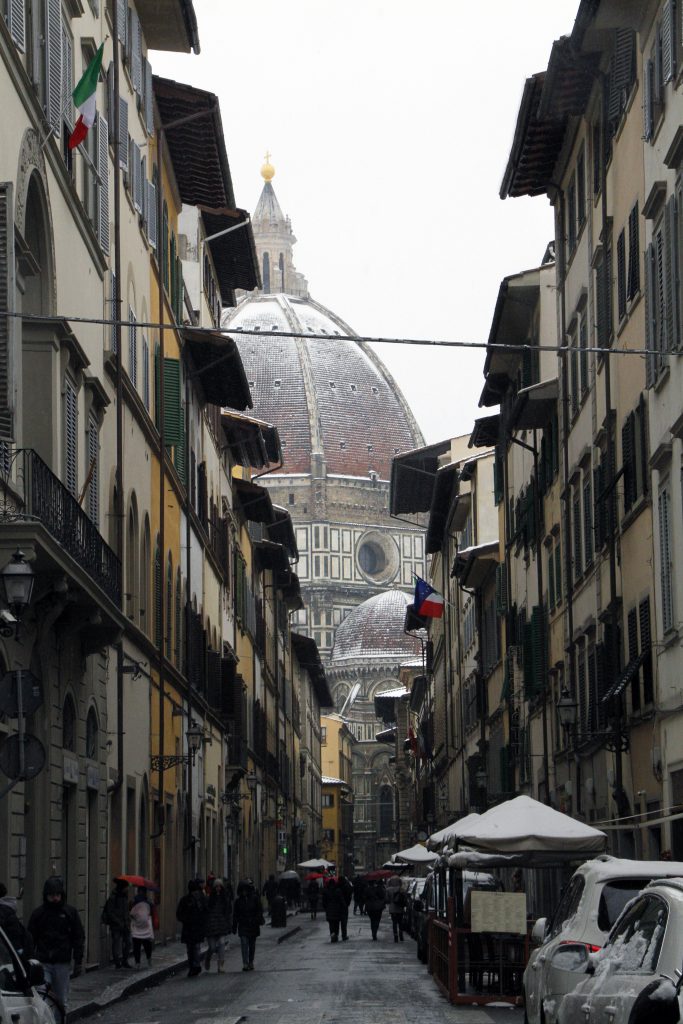
Tuscany is not a region of Italy where snow falls very often, so the flurry of white flakes has brought a bit of uncertainty and a lot of joy to all of us. Without much means for cleaning up after the snow, roads and sidewalks were slippery, and subsequently, schools and some public offices were closed.

Walking through the city, it felt like a Saturday, with families and couples enjoying the day together.
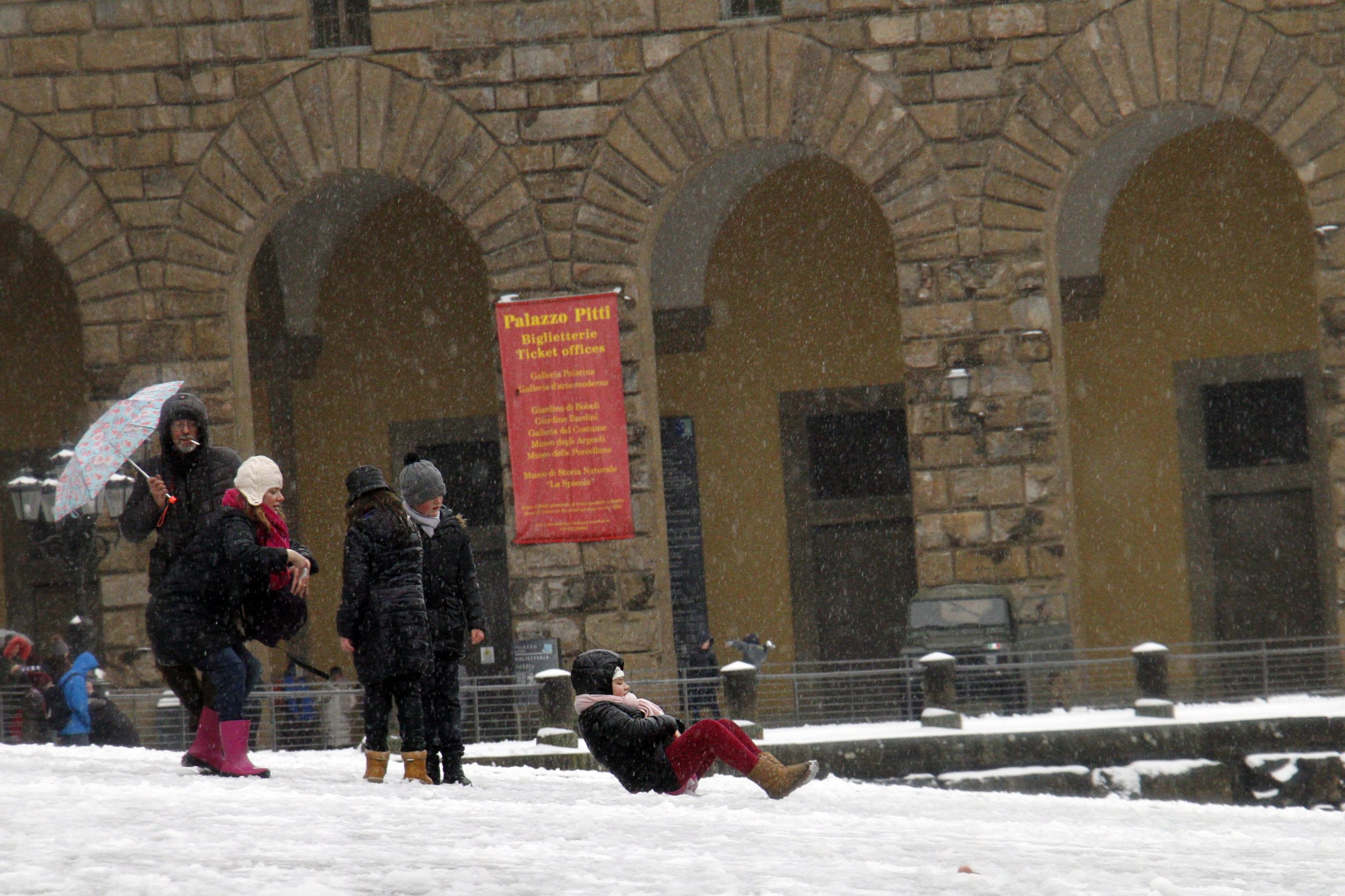
Children and dogs alike rejoiced in the snow;
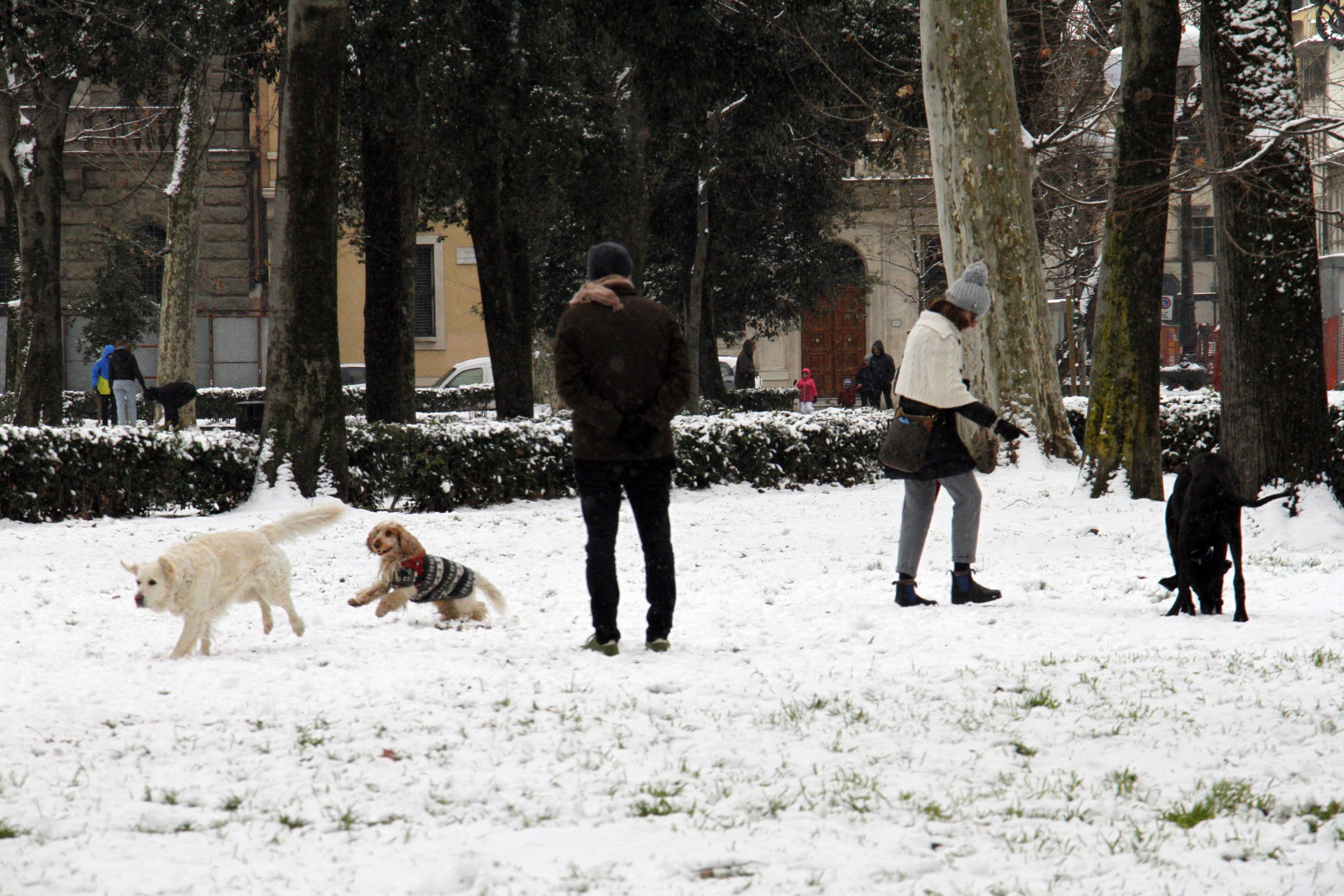
and parents offered their creative solutions for making the most of their children’s fun in the snow.
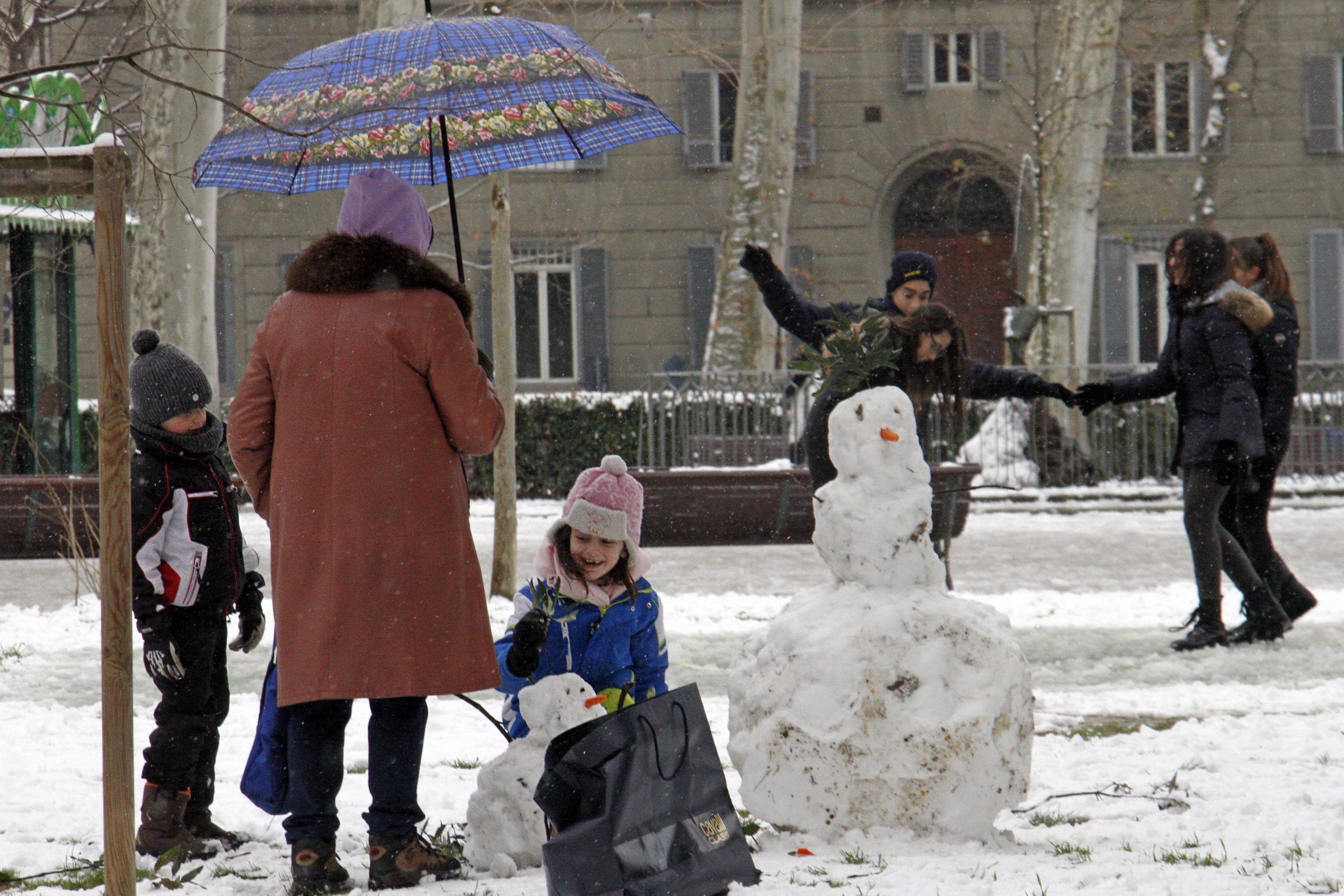
Today was a long workday for me and my work partner,
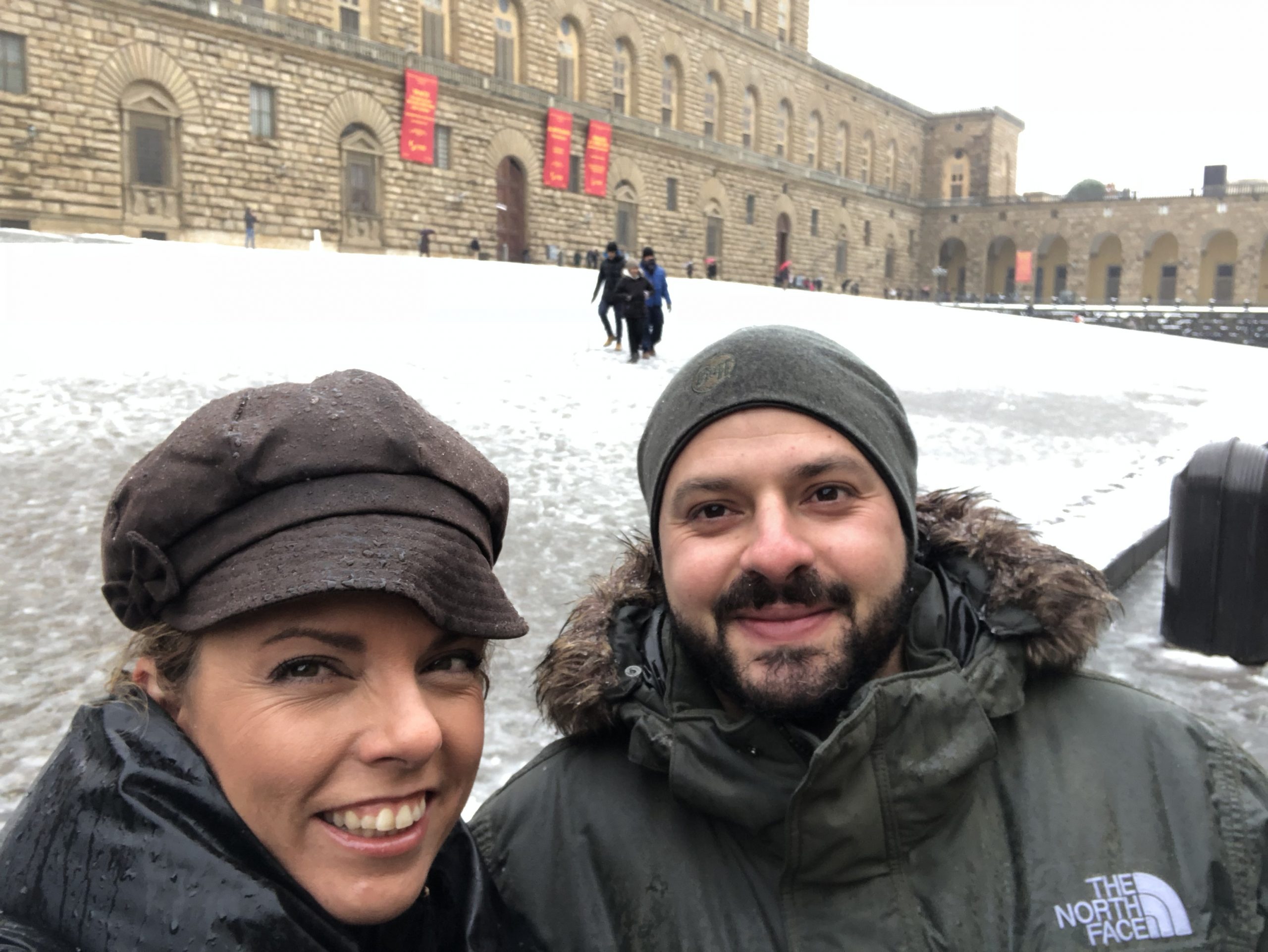
so we took advantage of being out and about
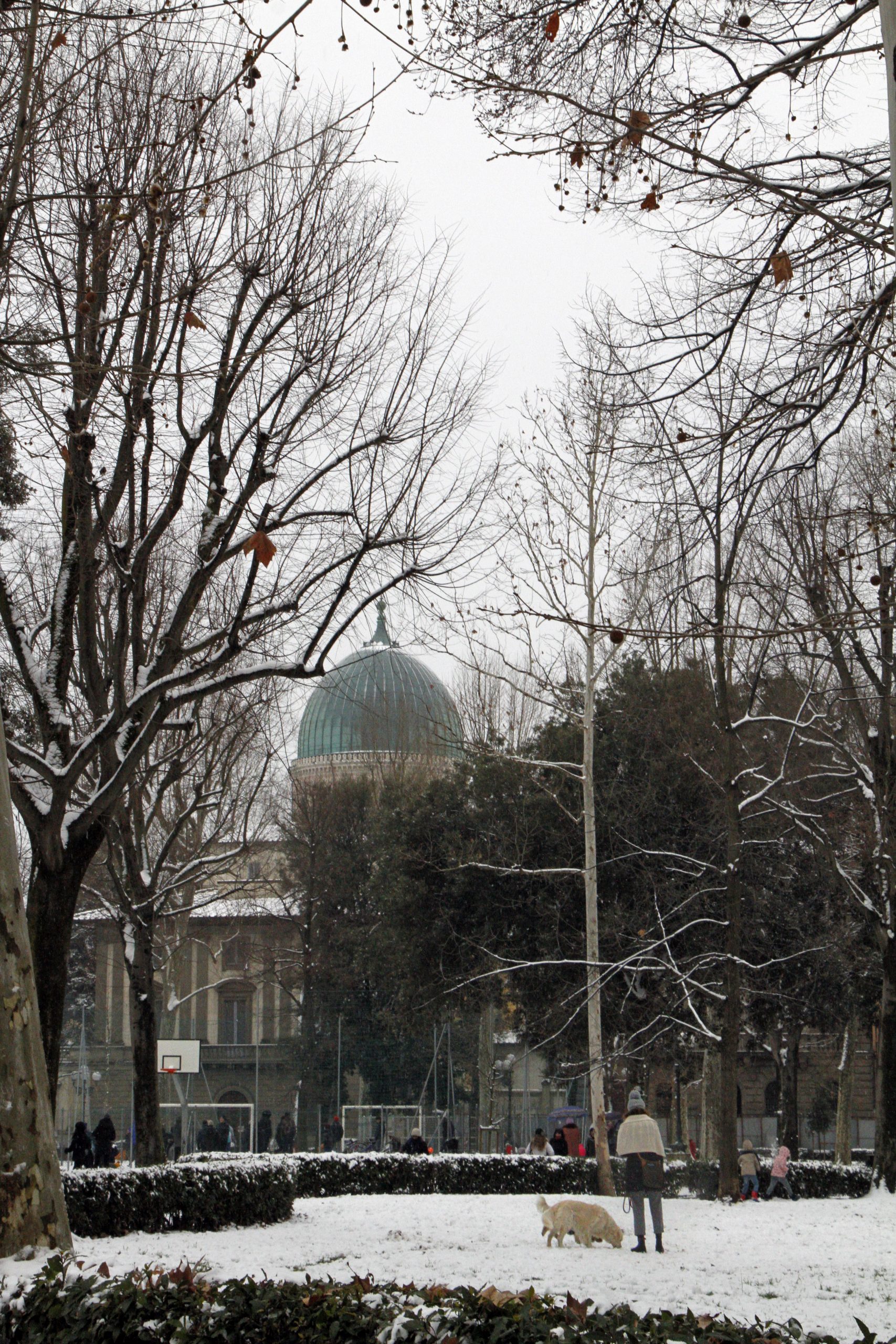
and dodging snowballs
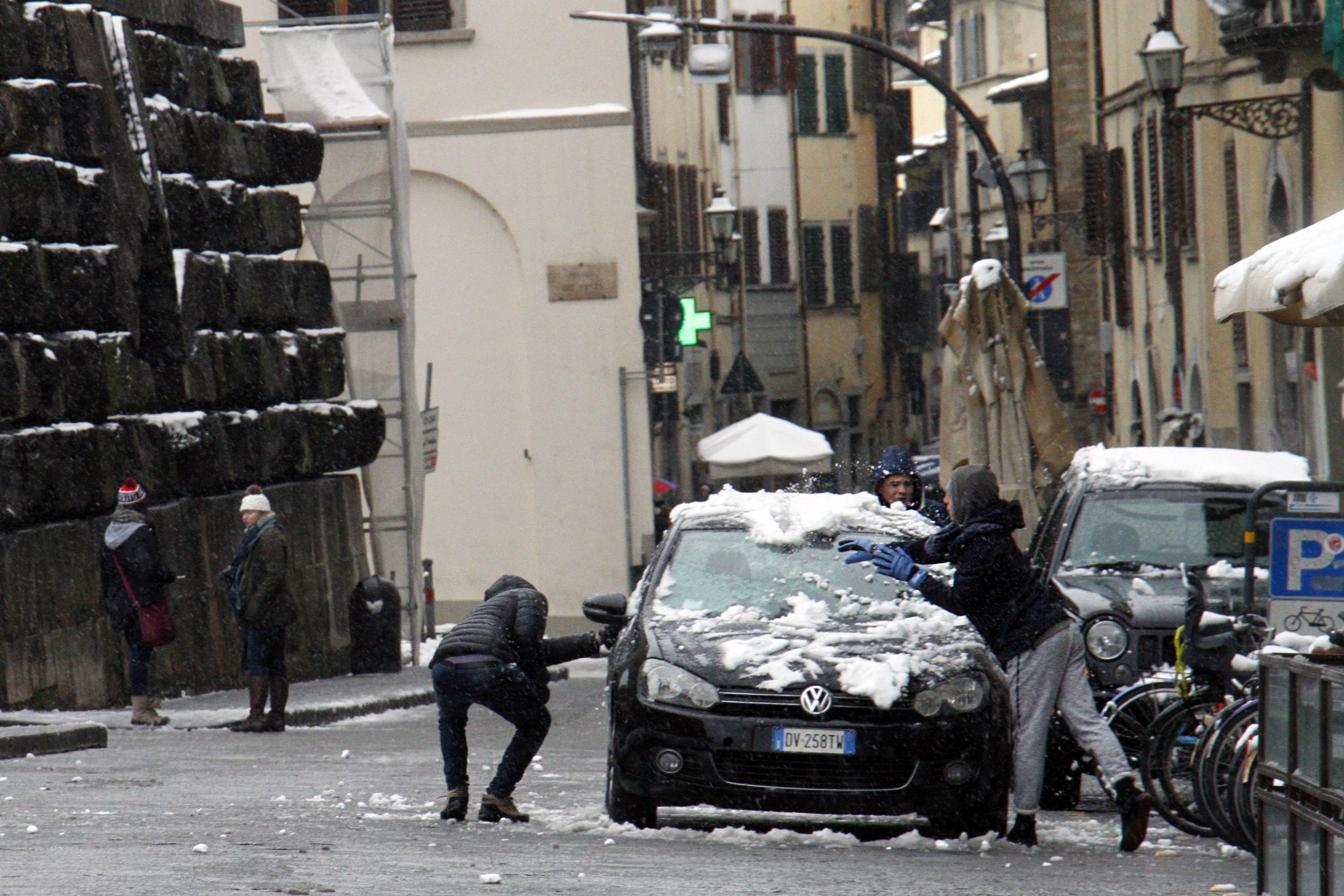
on this special day in Florence, that gave us a new perspective on the sites we’ve become so accustomed to.
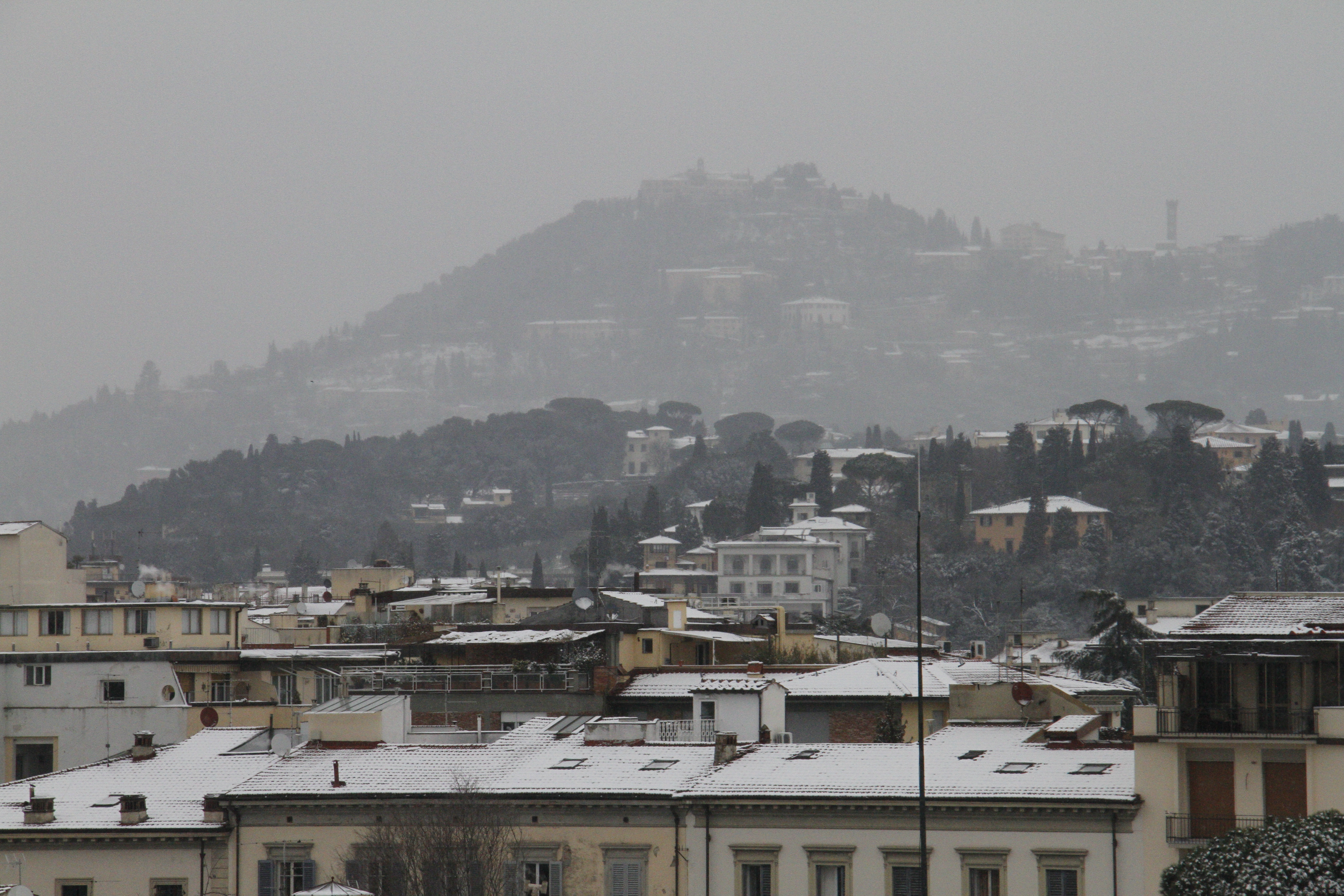
The winter wonderland was fleeting, nearly all but disappeared before the sun went down.
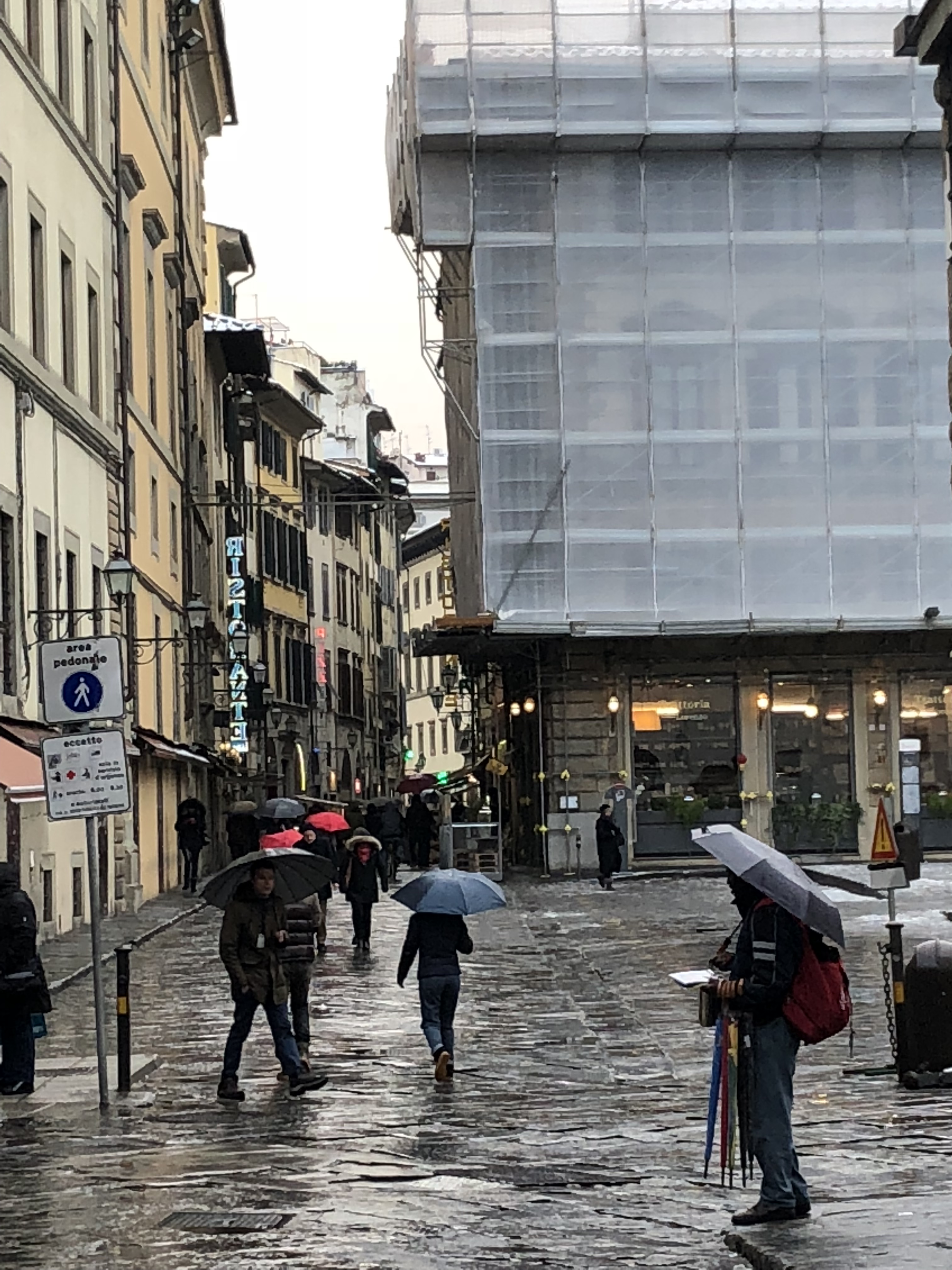
But the memories, and lots of photos, will last forever…
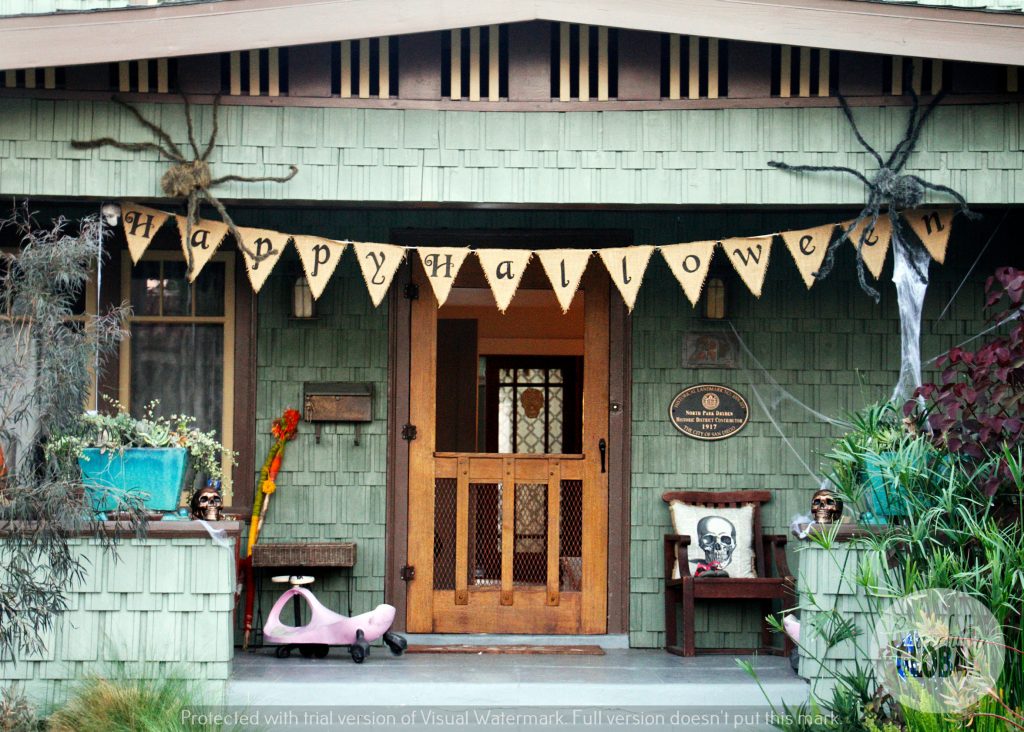
San Diego’s North Park neighborhood piqued my interest many years ago when a tiny street called Ray Street dotted with artist studios started welcoming the public to their studios every month. Prior, I had only thought of North Park as a fairly crime-stricken region of San Diego that was best to avoid. Fast-forward a decade, and the neighborhood is booming with businesses and new residents, but most artists can’t afford to be there anymore. A downside of neighborhood redevelopment. Fortunately, the upsides are numerous, including the creation of the North Park Historical Society in 2007, which is the local group behind the official designation of the North Park Dryden Historic District, which boasts several blocks of California bungalows and Spanish colonial revival homes. I watch the changing of the seasons jogging the streets of this gorgeous neighborhood as homeowners enthusiastically decorate their already eye-catching homes.
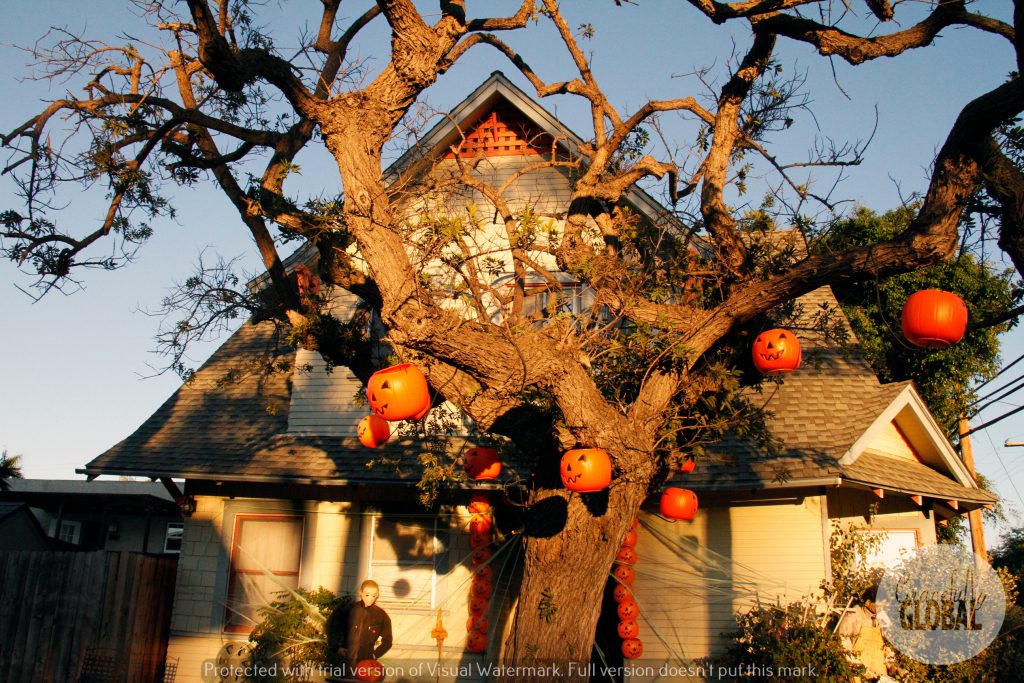
And my favorite season of all to enjoy this neighborhood is – you guessed it – Halloween. These homeowners are so creative and artistically inclined with their spooky decor.
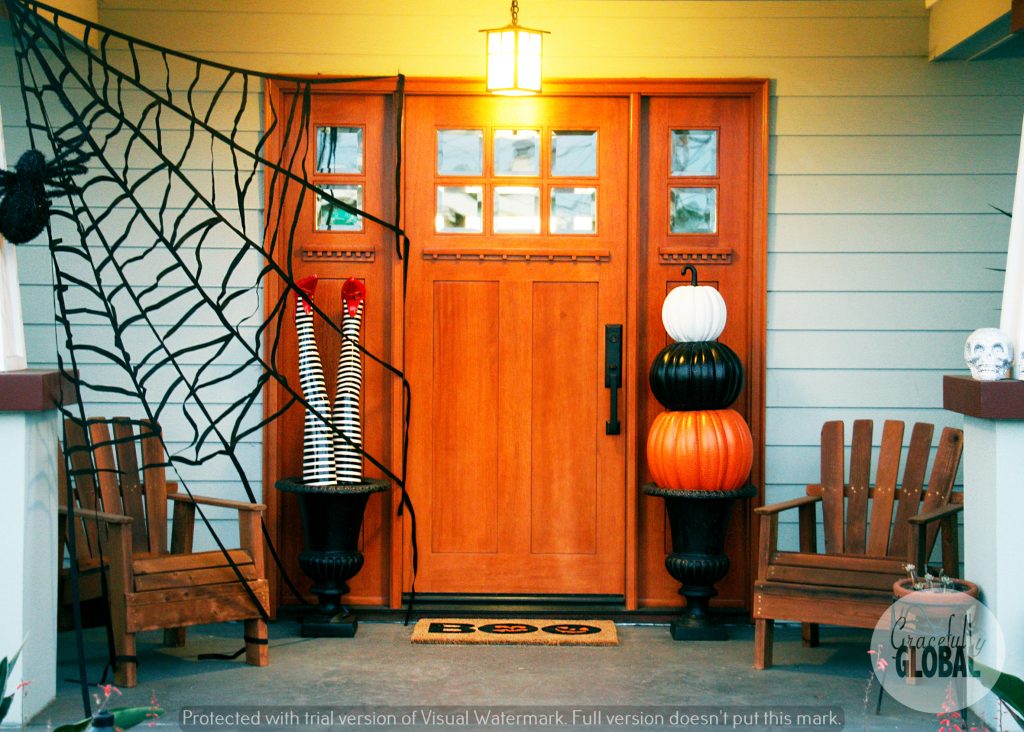
If you are visiting San Diego or live here, pay a visit and take a nice long stroll at dusk along 28th and Pershing Streets, bordered to the north by Landis Street and to the south by Upas Street, and everything around and between.
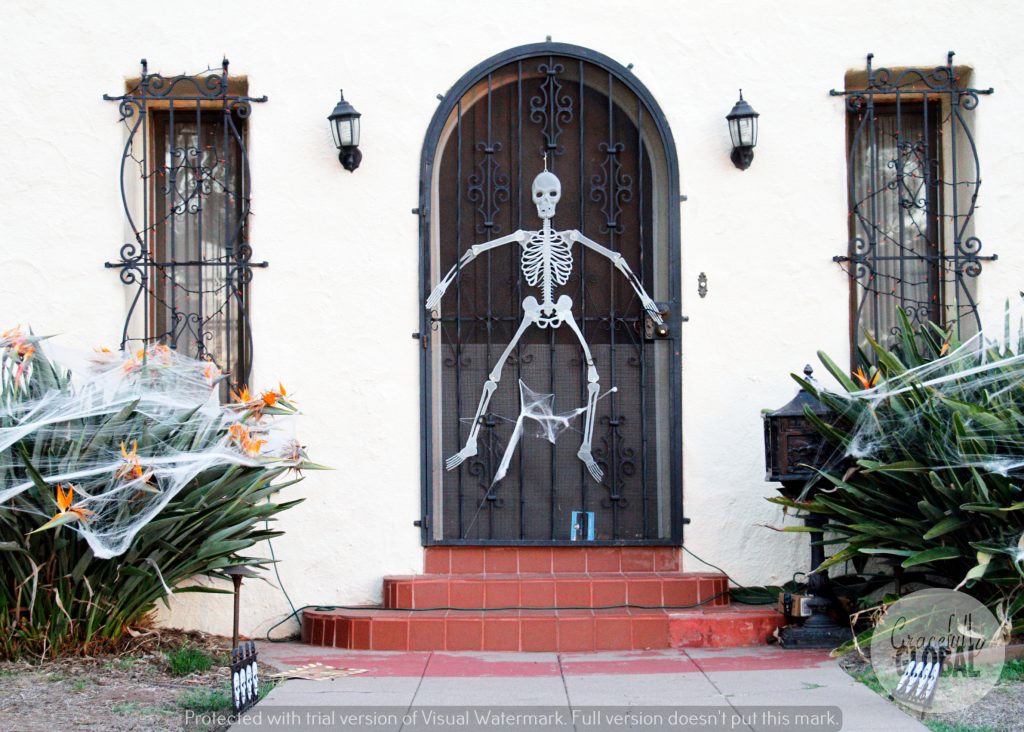
Enjoy a trip back in time, a lesson in California architecture, and a good laugh at these Halloween decorations with a sense of humor.
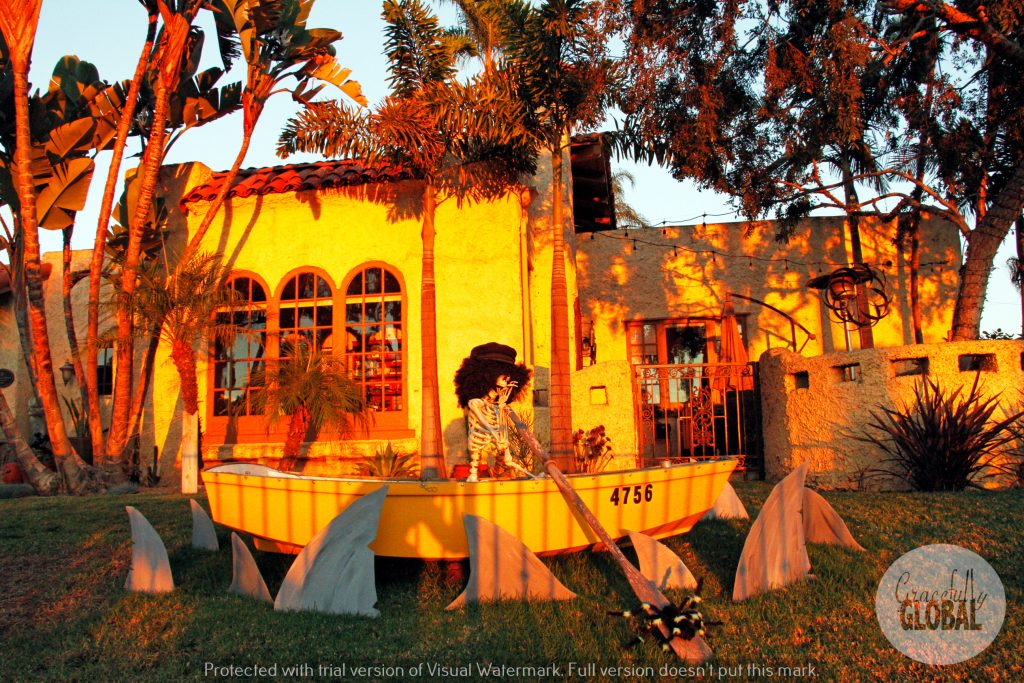
And the best part is no costume is required.
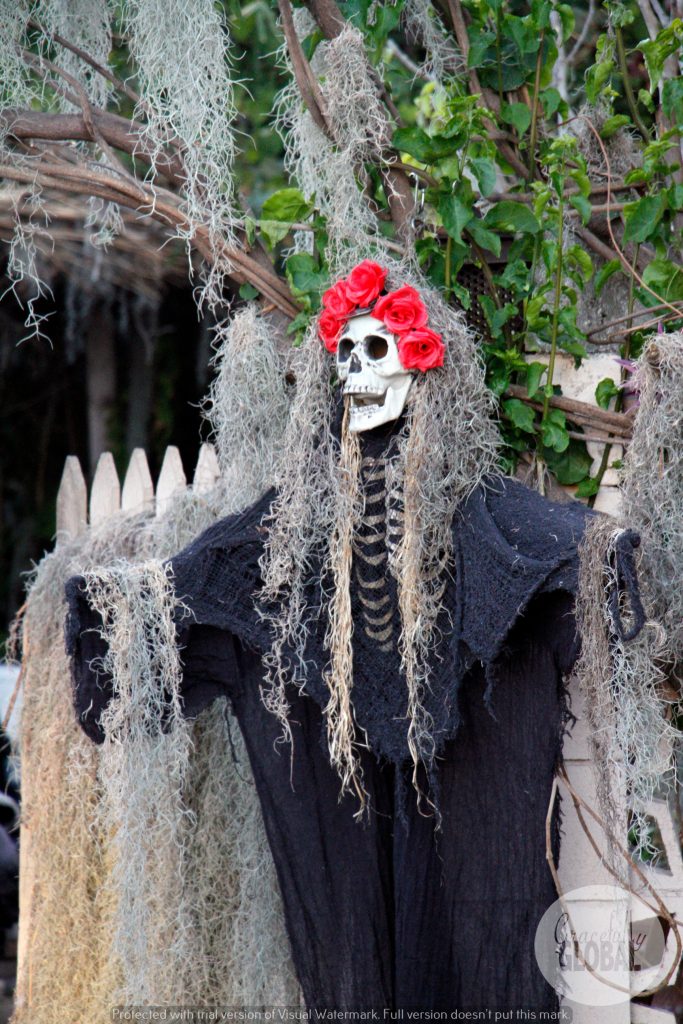
Although, if you are so inclined, your costume will be admired by the neighborhood joggers, like me, and, no doubt, the homeowners too!
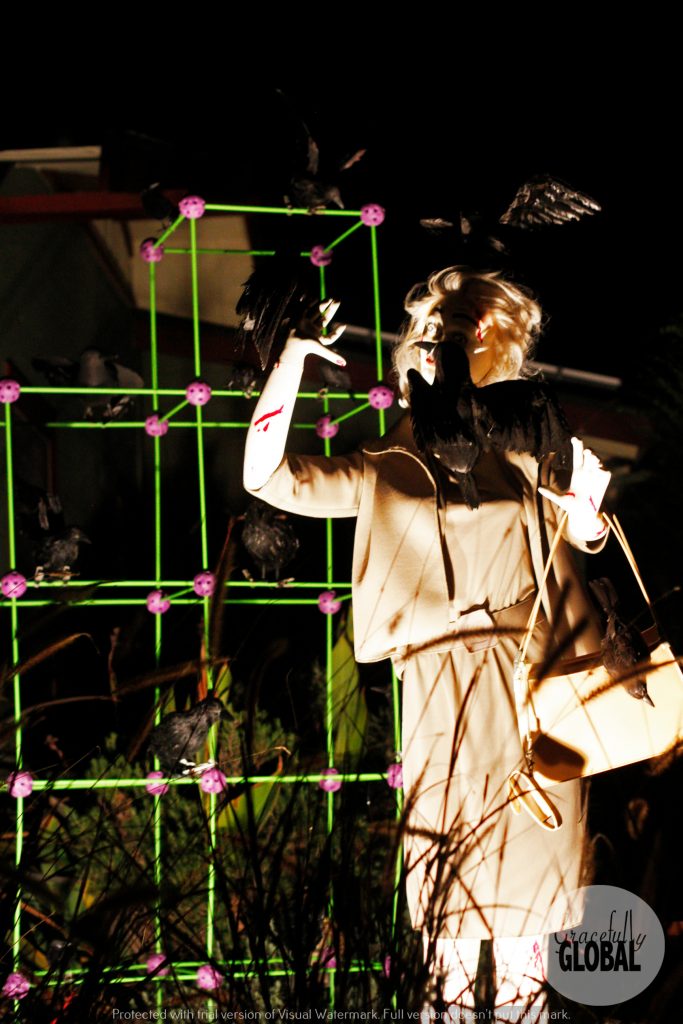
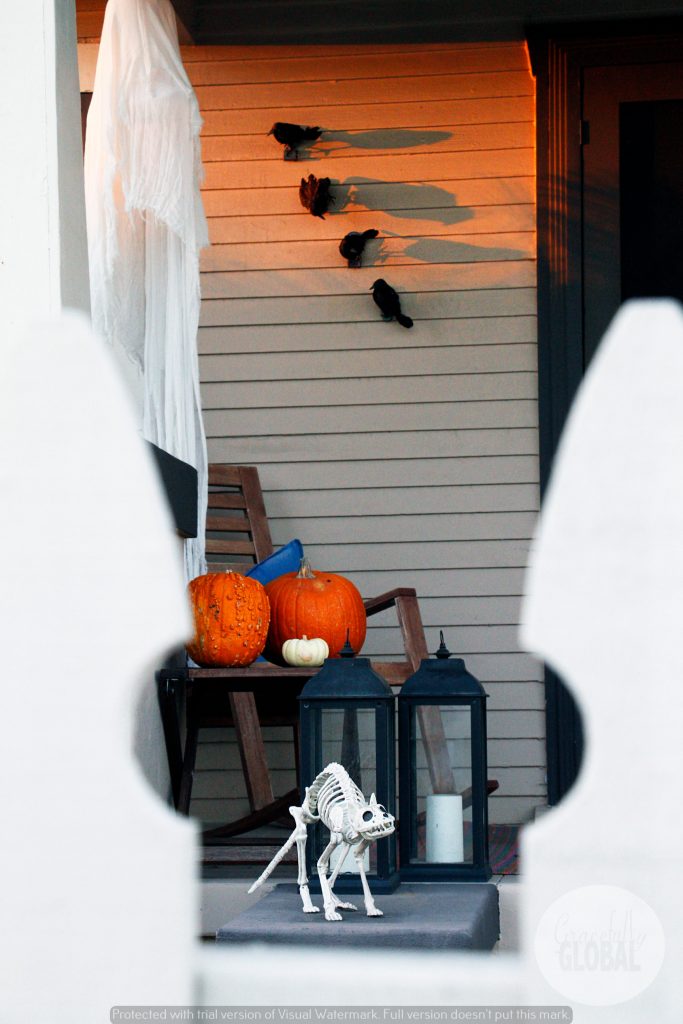

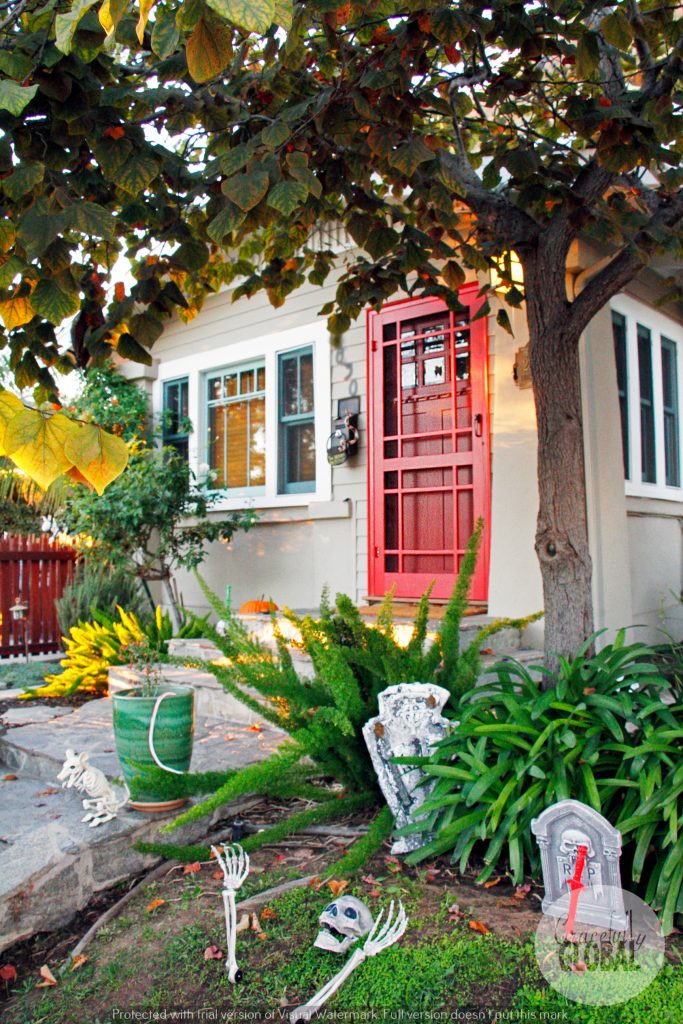
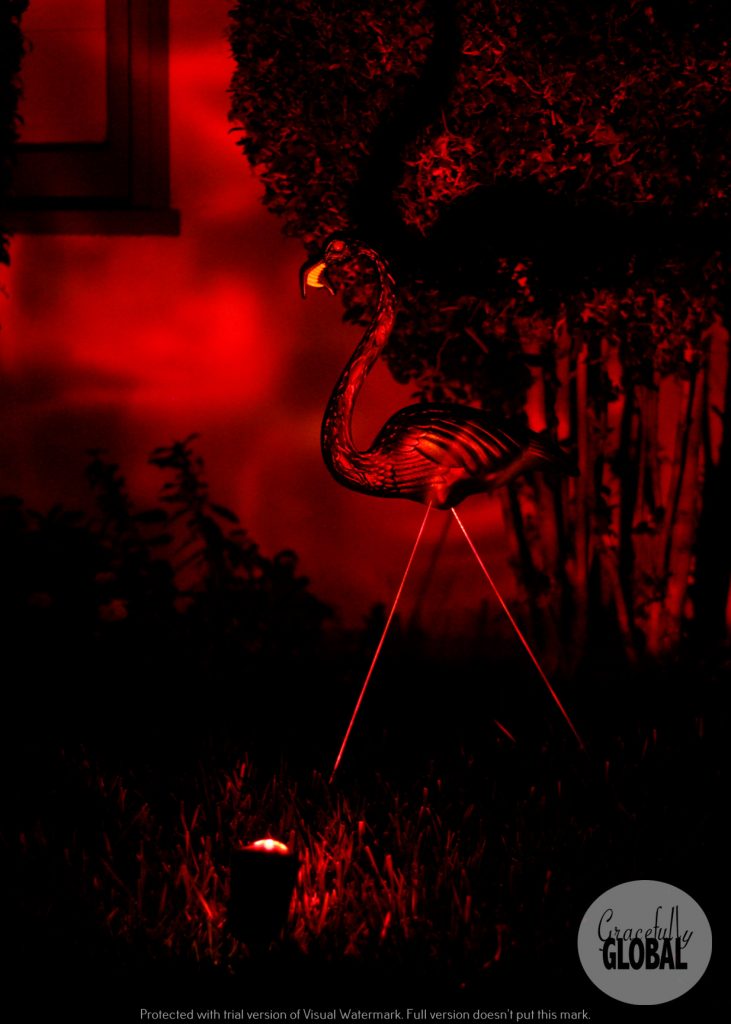

If you’re interested in seeing some fascinating historical photos of the neighborhood and learning more about its history, this PDF by the Save Our Heritage Organisation is a great read.
My time in Ireland this year developed in me a love for the Irish that will never go away. Of the many qualities I fell in love with about the Irish is their love of music, poetry, and performance. This was the connection to my family heritage that I subconsciously sought after. My grandpa was a first-generation Irish-American and a paid actor in FDR’s Works Progress Administration. This video prompted my dad to tell me for the first time that my grandpa had also been a singing waiter in Brooklyn. The pieces of family history are slowly but surely coming together, and I thank my time in Ireland for a lot of that.
Since leaving Ireland, I’ve told so many stories of the special nights in the Irish pubs with locals singing and dancing, that I drove up a bit of demand for sharing the beautiful music and performance that I experienced. So, I decided to make my next vlog be a focus on the music I experienced during my trip. This is my edit of the sounds from a few of my favorite performances I witnessed, which I paired with video I took on my phone of some of Ireland’s beautiful landscapes. I hope you enjoy, and I hope you make it to Ireland soon.
Oh, and don’t forget to turn your sound up! 🙂
Editor’s note: This column is written by my father, Rich Ryan, who I’ve invited to be a frequent contributor to Gracefully Global as “Dad’s Guest Blog,” as he calls it. He’s a retired professor, and he keeps himself busy with frequent traveling and writing a column in the local newspaper of my hometown, the Imperial Valley Press. This particular adventure we shared together along with my stepmom, Estela. This is the second post in the series, and the first post was written about Salvation Mountain, which you can read by clicking here. The photos are by me.
To the southwest of Niland’s Salvation Mountain is the Sonny Bono Salton Sea National Wildlife Refuge. Entry is free.
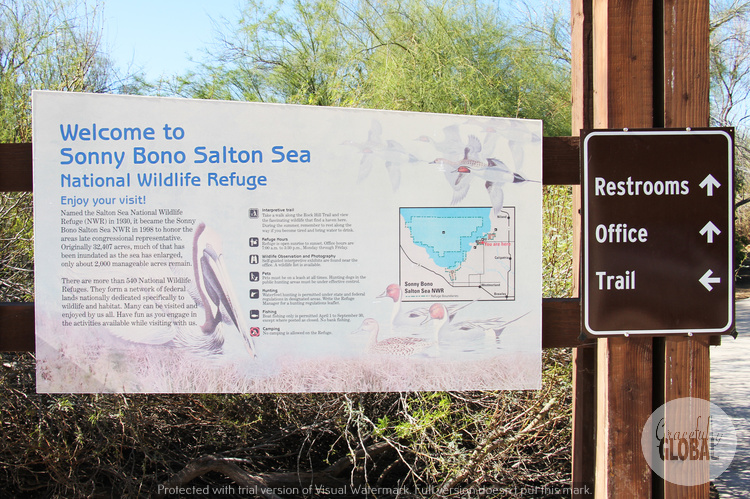
The Salton Sea which straddles northern Imperial County and southern Riverside County is an inland saltwater lake that is a stopover for seasonal bird migrations. The Refuge, a sanctuary and breeding ground for birds, is over 37,000 acres. The area is huge.

The Sonny Bono visitors’ center is easily accessible from California Highway 111. It is approximately a twenty-minute drive from Salvation Mountain to the Wildlife Refuge and less than two hours from Palm Springs. Driving south on California Highway 111, turn west on Sinclair Road which will bring you directly to the center’s entrance.
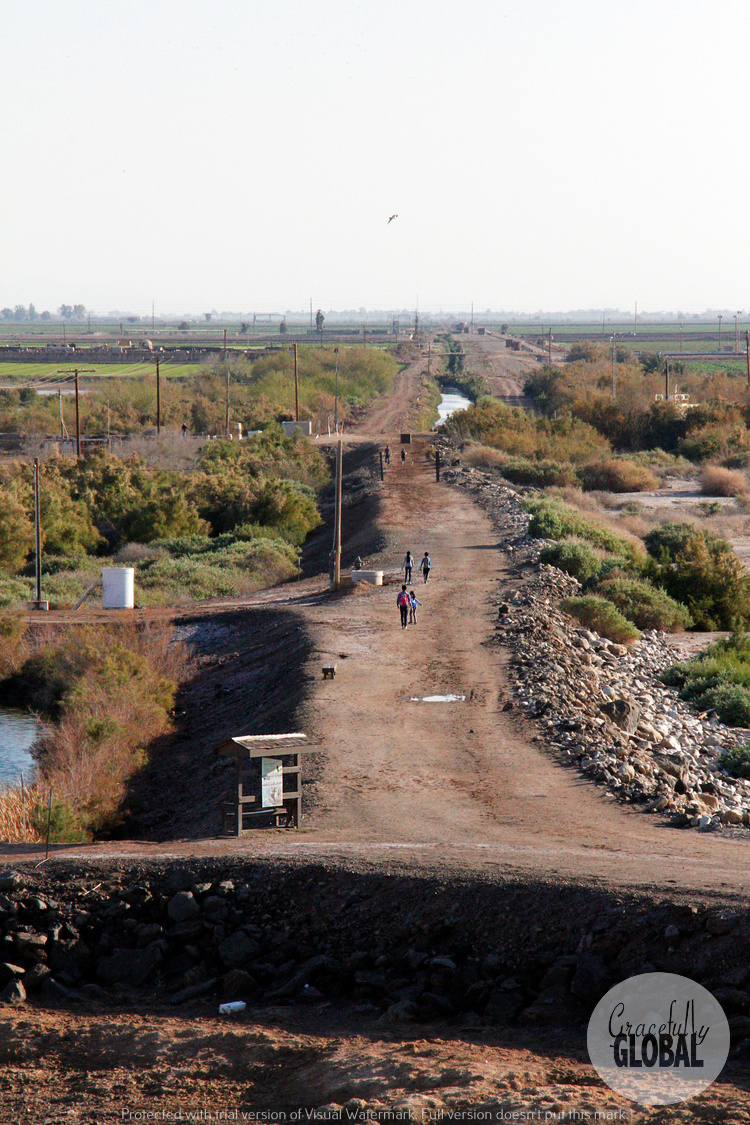
You will pass a series of huge geothermal plants that run along both sides of Sinclair. Signage is minimal so be alert. The visitors’ center is not fancy but possesses the basics: parking, a gift shop, informed docents, restrooms, and shaded picnic tables.

Next to the center is a large, unshaded viewing platform from which to observe flocks of migrating birds such as white phase snow geese feeding in an irrigated field. Bring binoculars. Migrating is the key word. These birds are not permanent residents so check the website for migrating bird information.
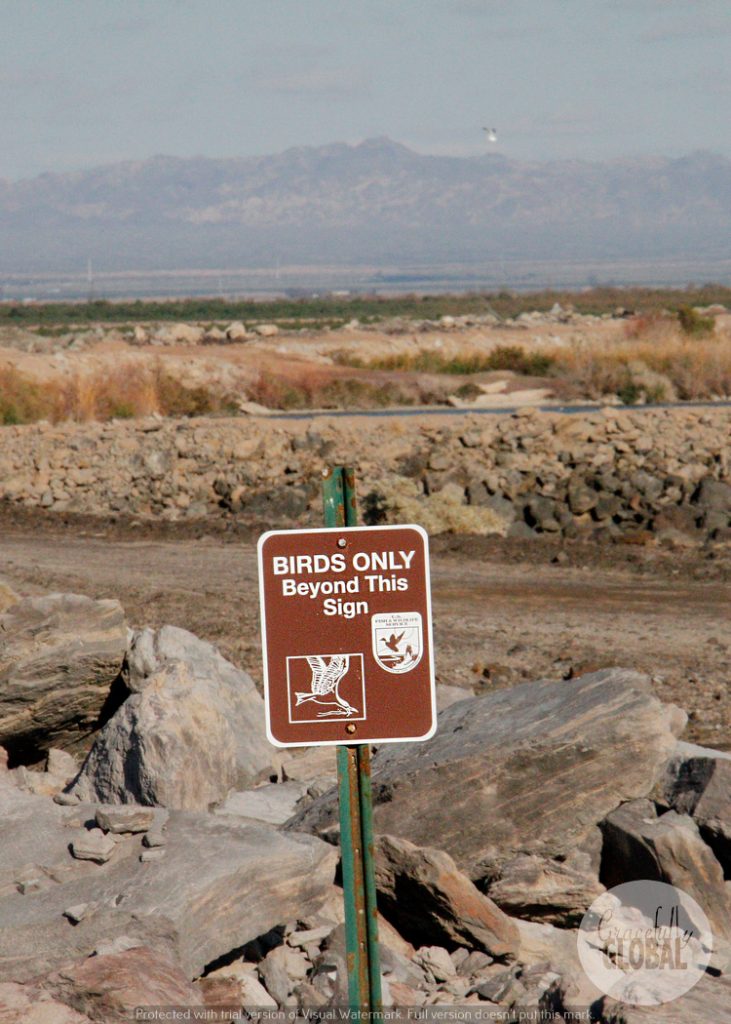
Why should you visit the Refuge? The Refuge is situated within the Pacific Flyway. If you enjoy the outdoors and watching wildlife in their natural state, this is the place to be.
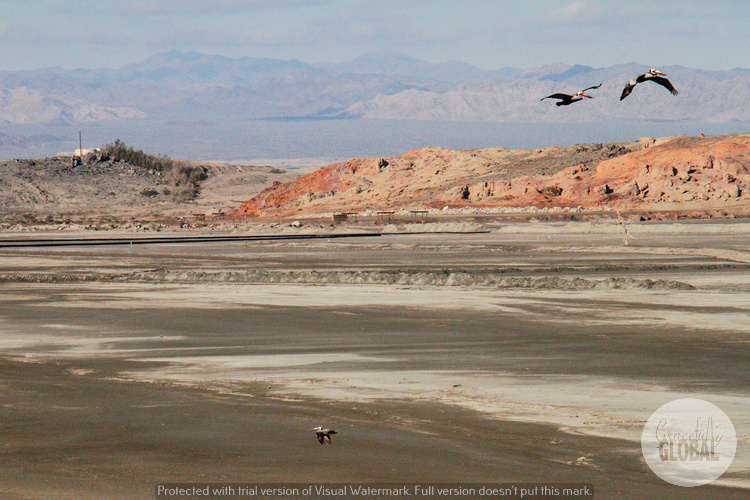
Birds from all over the western states, northern Mexico and Canada winter over here. Even during a brief visit, we saw dozens of pelican formations flying over and landing on the artificial islands established in the Refuge’s lakes.

Thousands of shore birds line the Salton Sea which is about a half mile walk from the visitor’s center. I was lucky on my first visit to startle a blue heron as I approached on a canal bank road. A great blue heron taking off is a majestic sight.

Do be weather-wise when visiting Imperial Valley. This is low desert, and from late spring to early fall temperatures will usually exceed 100 degrees Fahrenheit. It’s best to visit during the mild winter, late fall, or early spring. A sun hat and water are must haves. Enjoy your visit.
– Richard Ryan, Guest contributor
Instagram: @desert_rich
I must admit, as far as travel experiences go, visiting the Colosseum never ranked highly on my list of favorites. Until recently, that is. The mass confusion entering the Colosseum and the stress of dealing with their stringent yet non-communicative ticket office, followed by feeling pretty much like one of a million sheep, and not much to do once inside other than take selfies or watch other people take selfies really downgraded the experience for me.
When my extended family came to visit Rome and asked me to help them organize their trip, I was struggling my way through the Colosseum website and thought, “There must be a better way.” And entered, The Roman Guy. But more on that later.
Frankly, Colosseum ticketing options are not ideal. I’ve had first-hand experience through my work managing on-site logistics for groups of American and Australian university students with CISabroad. Often we opt to pay the reserved group entry (which is an additional cost on top of the ticket to enter). The group entry has its own entrance a bit closer to the metro stop than the single ticket entrance, but, ironically, there is always a line at the reserved group entry, and eventually, this “special” entrance converges with the non-reserved single ticket entry line.
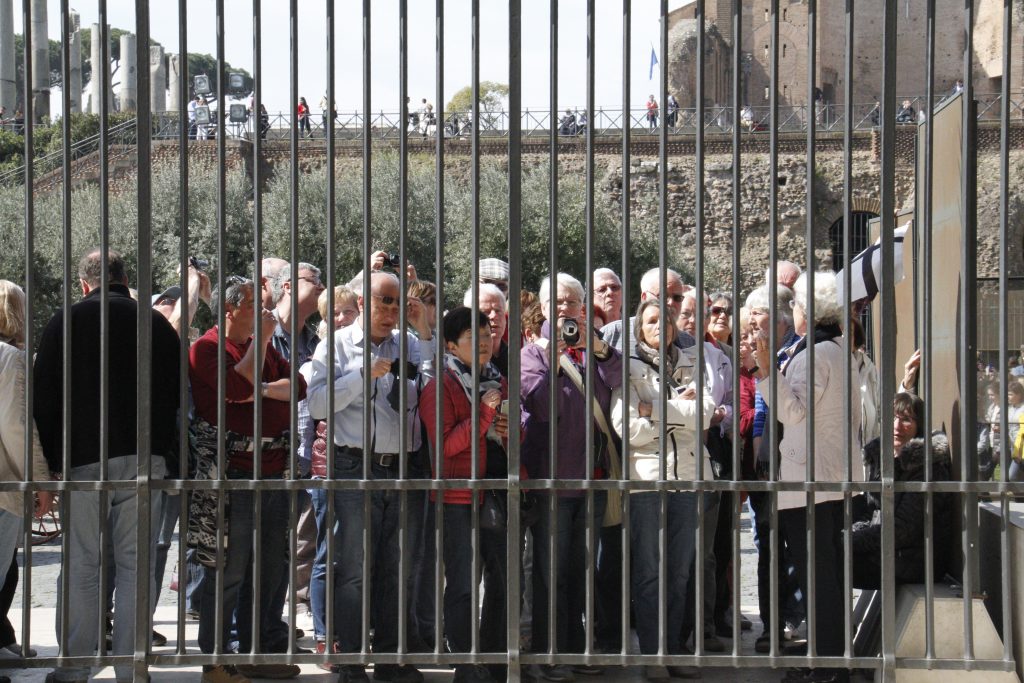
Being fairly disillusioned with the group entry options, I eventually decided to try arriving early with one of my groups and give the unreserved entry line a go, only to find out after waiting a half hour that I was prohibited from purchasing more than 12 tickets at a time. I’m not sure how I would have known this rule in advance, but whatever the case, now I finally understood the need for reserving the otherwise unhelpful group entry in advance.
The final solution for entry into the Colosseum is to purchase your single tickets online in advance and print them out at home. Then when you arrive at the single ticket entry line, you have access to a special line for people who purchased online, which moves a bit faster.
All that to say, there isn’t really an ideal solution. Until I finally rolled up my sleeves and was determined to find a better way. That’s when The Roman Guy came in. The Roman Guy sounds like one guy, but it is actually a robust Italian tour company based in Rome. They have a lot of different tour options for exploring the Colosseum with a guide such as Colosseum underground and floor tours.
The idea of having someone else manage the craziness of getting us into the Colosseum was reason enough for me to book, but the tour also resolved my other primary disappointment with visiting the Colosseum: the lack of information about Colosseum history available to visitors. Having a trained guide would really open up the experience for us, giving us the narrative that would make the place come alive.
The day of our tour arrived, we met our Roman Guy guide, and everything started out smoothly and normally. But then everything was suddenly different.
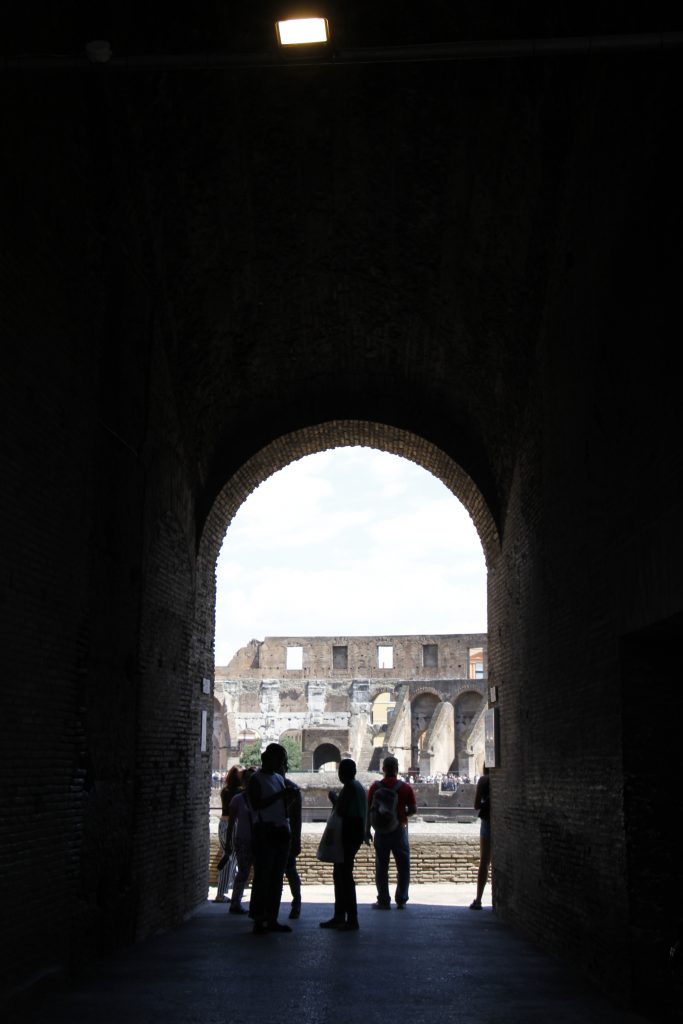
We passed the mobs of people waiting in the three lines I had mentioned, kept walking around to the back of the Colosseum, and stopped in front of a back gate. I was flabbergasted. There was no one at this back gate. Our guide simply called the name of the guard, he came over, opened the door for us, and we walked into the Colosseum.
HALLELUJAH.
Instead of the typical mixture of stress, anxiety, and annoyance that I carry with me after finally getting through all of the hurdles to enter the Colosseum, we merely just walked in. I was in heaven.
We then proceeded to walk onto a deck perched just above the floor of the Colosseum. Every trip I’d made here, I’d seen people on this deck from the other side, and always wondered what this magic place was that was not accessible to us. Well, now I finally understood.
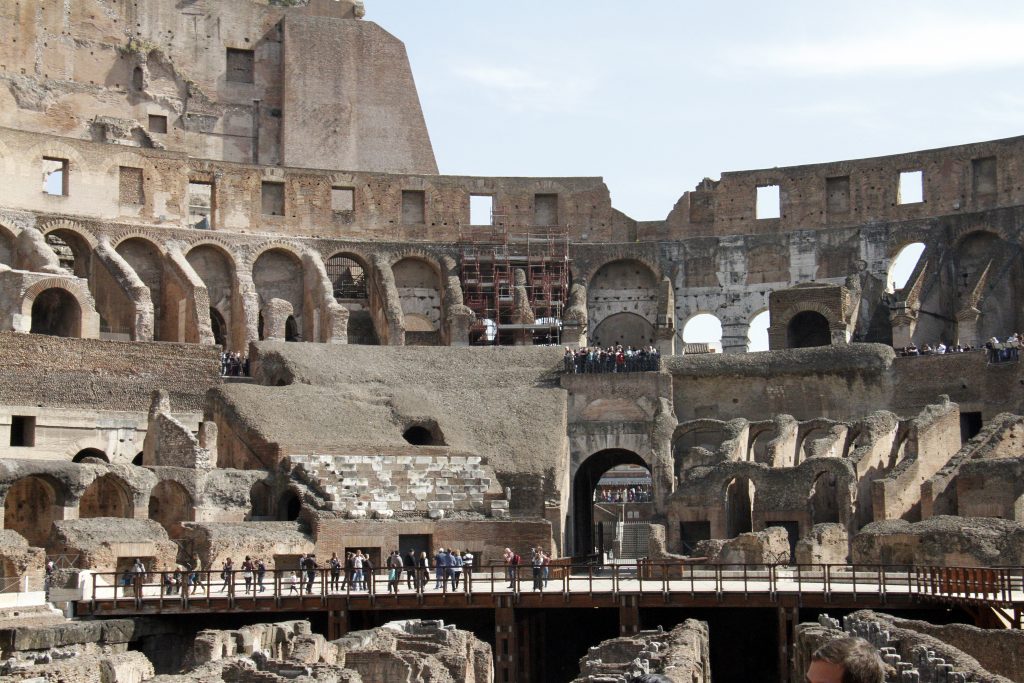
This area was regulated by Colosseum staff, and only a certain amount of visitors can be there for a given amount of time (20 minutes or so, maybe a half hour), meaning there was plenty of space to move around and take pictures. Since The Roman Guy is registered with the Colosseum, they can reserve this special entrance onto the Colosseum floor (and other restricted access areas), and bring people in through the back entrance.
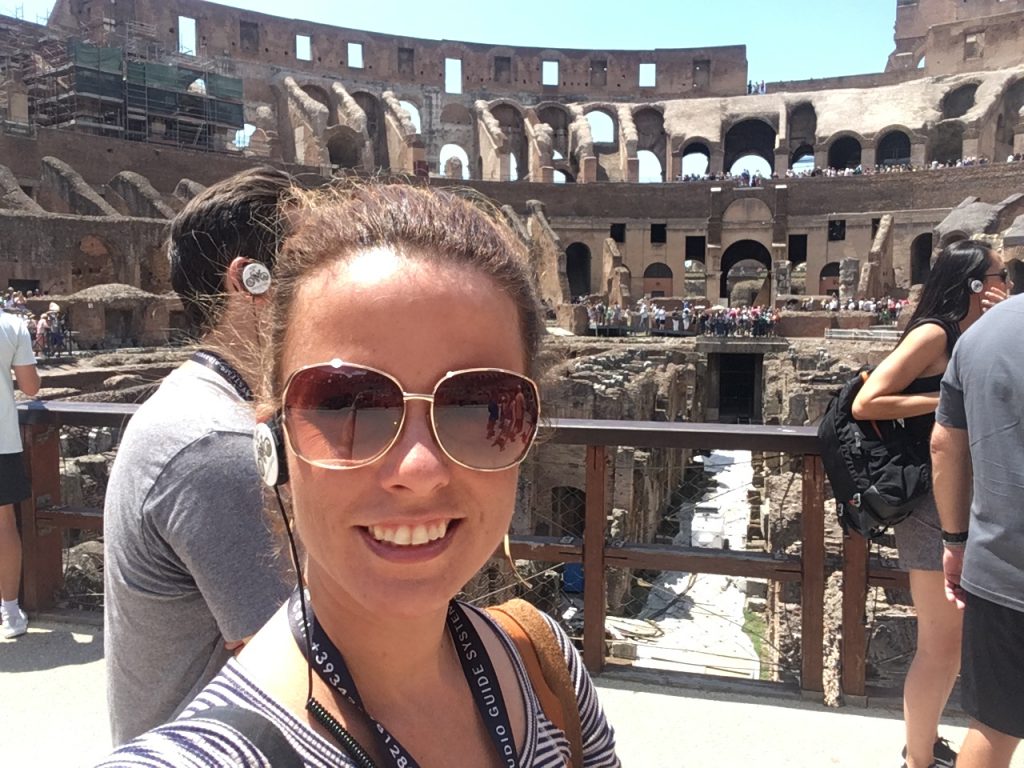
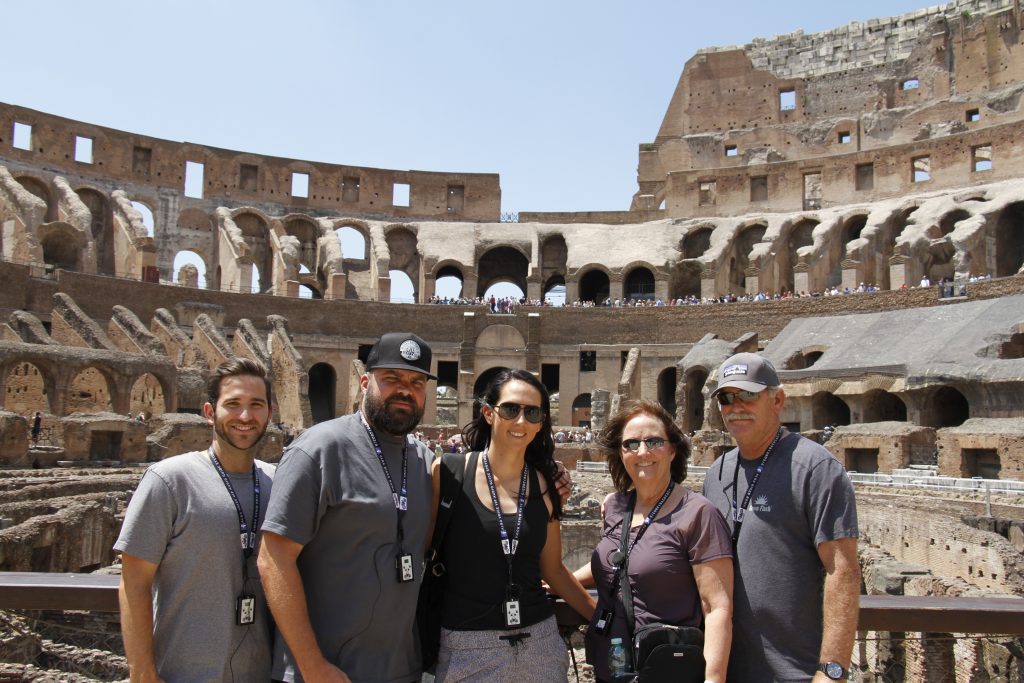
We had plenty of time (and space) to take photos, and then our sweet Roman Guy guide, an archaeologist, started explaining the highlights of the Colosseum history.
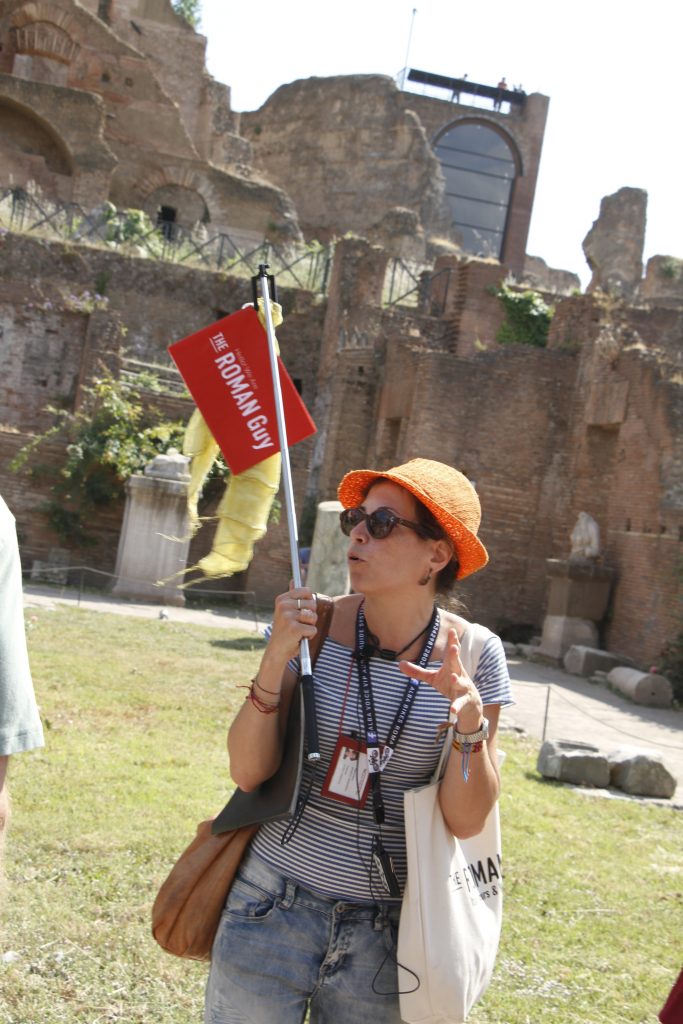
 Our sweet and knowledgeable guide had great visuals to accompany her talks.
Our sweet and knowledgeable guide had great visuals to accompany her talks.We walked around nearly the whole Colosseum together, up to the second level, then ducked here and there, finding shade, water, and places to rest, as she explained fun facts. My favorite trivia was about the female gladiators. I had no idea they existed! We also learned that the ruins across the street were ruins of a gladiator training school. So cool.
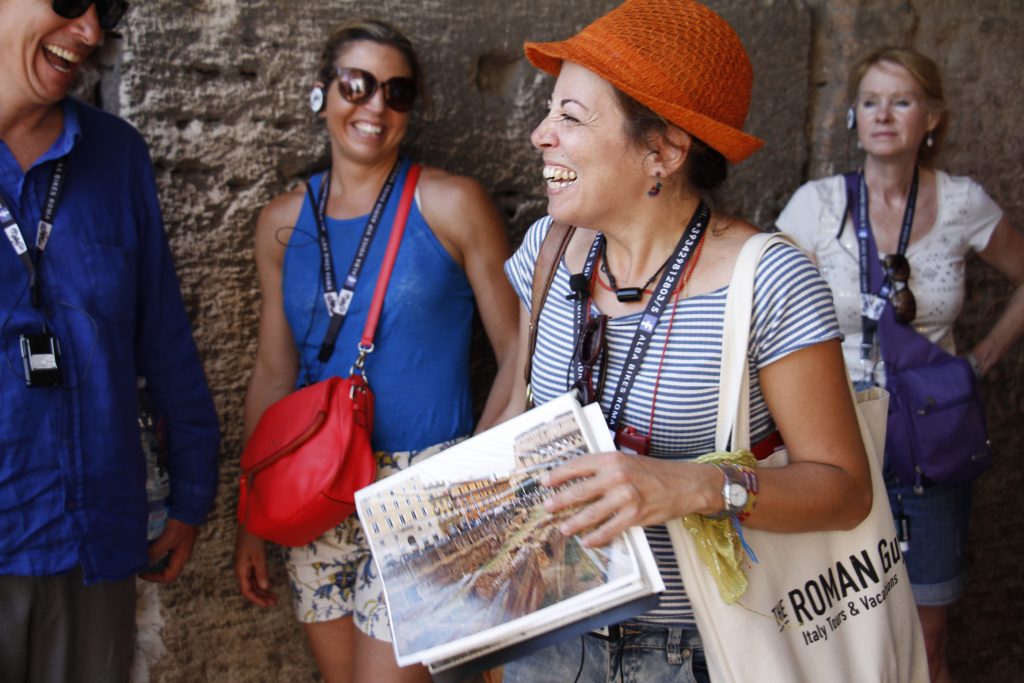
The second part of our tour took place across from the Colosseum at the Forum and Palatine Hill, where we learned about the fascinating Virgin Vessels, and our guide showed us where Caesar was cremated. I’d been to the Forum many times but had never noticed the tiny sign that points out this incredible history of the temple, now partly in ruins.
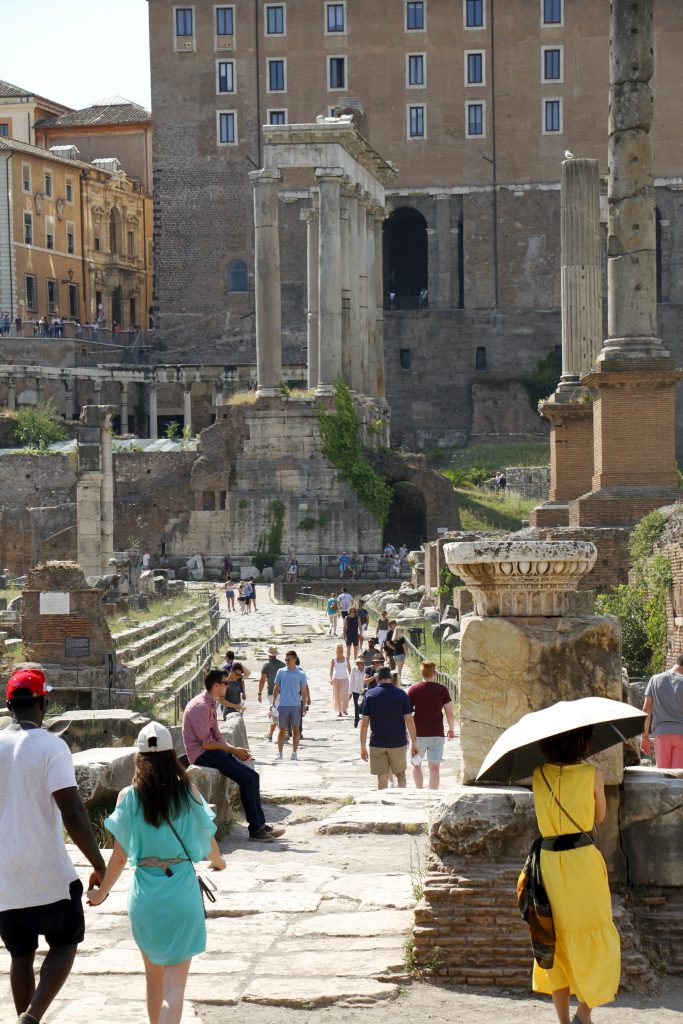
I had a few favorite moments, including when she pointed out a piece of what would have been a massive statue, and now all that remains is a foot. I wouldn’t have noticed it otherwise, and it is rumored to be good luck to touch the pinky so I couldn’t pass up the opportunity.
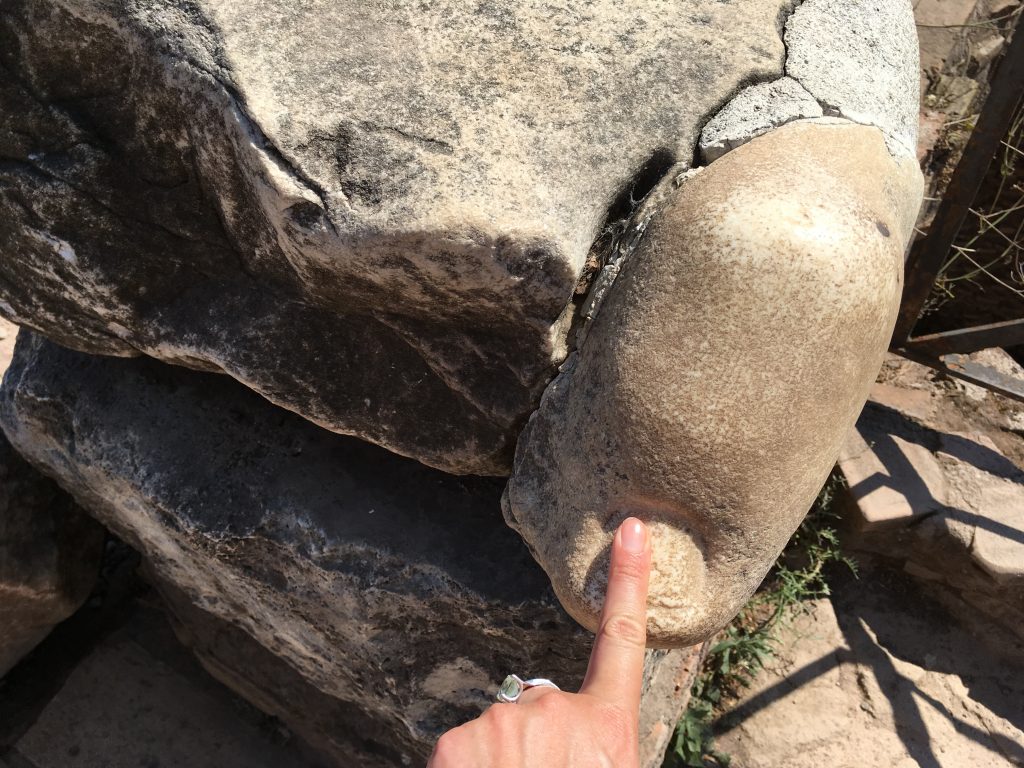
The tour finally wound down, and our guide shared one last insight with us. “Rome is like lasagna,” she said. “It is full of many layers, all of them worth discovering and savoring.”
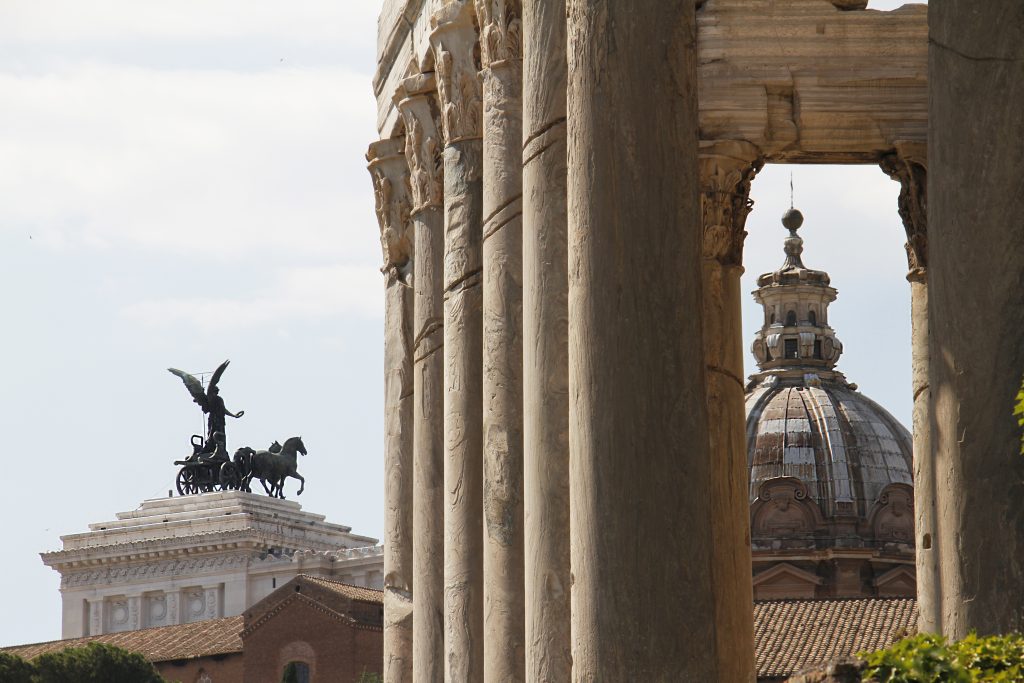
I loved that moment, as it really made me think, and appreciate all the insight that this lovely archeologist guide brought to our experience that we would have missed if we had done it alone. It is an experience that I won’t soon forget.
Big cities can be quite a puzzle to get to know, and Rome is no exception. Even tougher still, Rome’s huge tourism economy makes it tricky to discover how to deviate from the beaten path. I’ve been to Rome about ten times, and I still don’t feel like I could confidently recommend a restaurant for dinner, for example.
When my extended family called me in Bologna a few months ago and told me they’d be in Rome and wanted me to show them around, I knew it was definitely time to brush up on those dinner recommendations, among other things. It was time to work on my Roman game.
It was a huge relief when they told me they were willing to spend a bit of money for the experience they wanted to have. Having a fantastic time in Rome is totally possible without spending much money. The catch is that it takes quite a bit of advance planning and research, which they didn’t have, and neither did I, really.
I immediately thought of finding them a high-quality walking tour of Rome. In my work managing logistics for CISabroad, I’ve come to really respect a good city guide. That being said, not all guides are created equal, as the job requires a curious combination of social aptitude, knowledge, and passion for their city. If you manage to find a good guide, what they offer is invaluable: a personalized, in-depth local’s perspective on the city you’re visiting. Which is kind of the ideal offering when visiting a new place.

Once I find a guide I really like, and the company they work for is easy to work with, I find I usually like all the guides from that company, and can explore other tours they offer. But finding that company can be tricky. For my family’s trip, I was searching for a great guide and a unique tour that didn’t focus too much on history or culture, as my family is more of the sporty type. So when I stumbled upon The Roman Guy’s Cocktail bars in Rome: Evening Walking Tour, it seemed to be the perfect solution and I booked it immediately. Let me tell you, my family really appreciates a good cocktail. The Roman Guy is a big operation, offering many different types of tours, and lots of guides. They pretty much bent over backward to get my family set up with three tours, with just a couple of days notice.
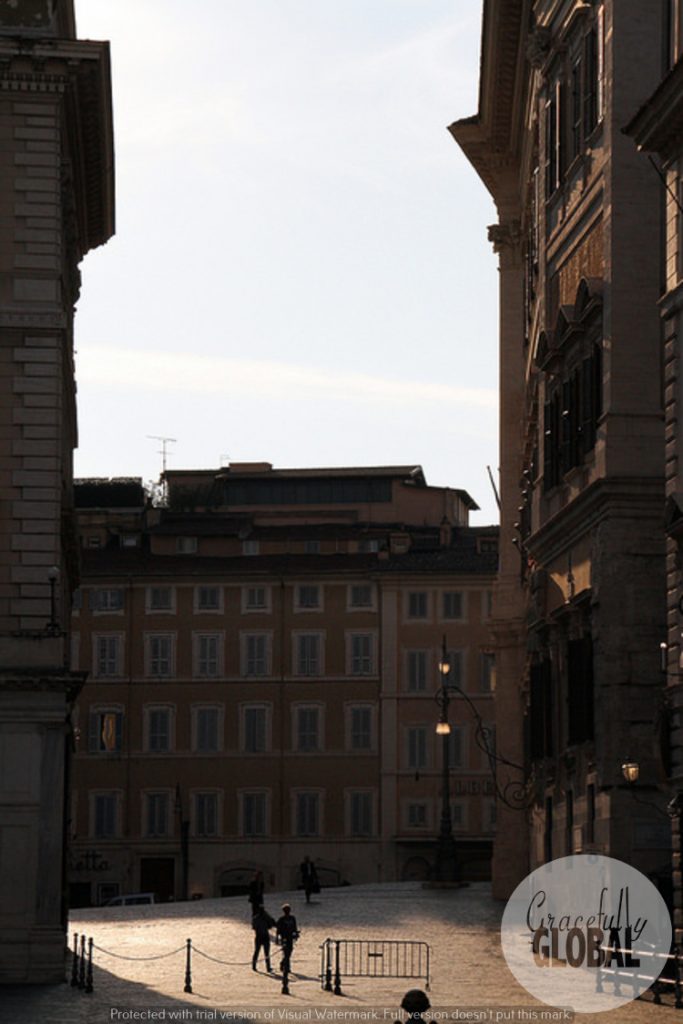
We met our The Roman Guy guide, Fiona, in Piazza Colonna. She immediately endeared herself to us, admitting she was thrilled to lead our private tour, as she needed to get away from her half-Italian, half-Australian teenage son who had just started his summer break. “Our apartment is feeling smaller and smaller these days,” she chuckled. She is the kind of person you hope to meet at a cocktail bar for some fun small-talk with someone other than your family members, who you’ve been talking to 24/7 since your vacation started.
We wove our way to the first bar, and Fiona casually introduced my family to the important landmarks along the way, like the Tempio di Adriano, which was in the neighborhood of the first bar we visited, sporting elegant cocktails and the coolest Jell-O Gin shots set in lemon skins I’ve ever had (ok, admittedly, the only Jell-O Gin shots in lemon skins I’ve ever had).
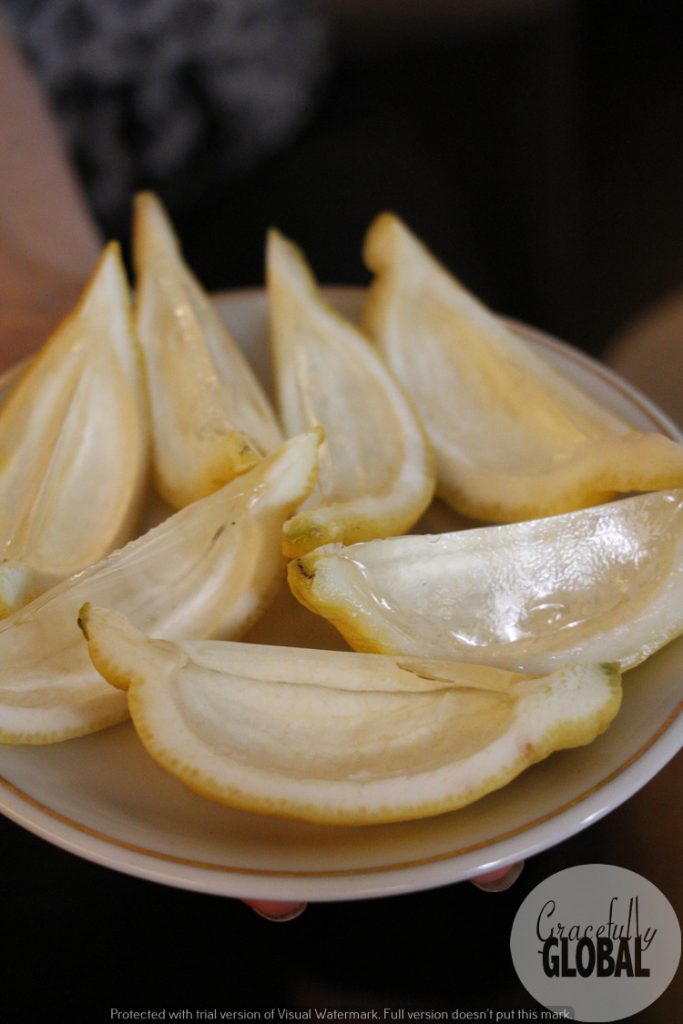
Next stop was the Pantheon, where Fiona explained its intriguing history to my family, filling in the blanks of my less-than-adequate description from when we had been by the Pantheon earlier that day. What can I say? My forte is logistics and not history. I can’t do it all, sigh.
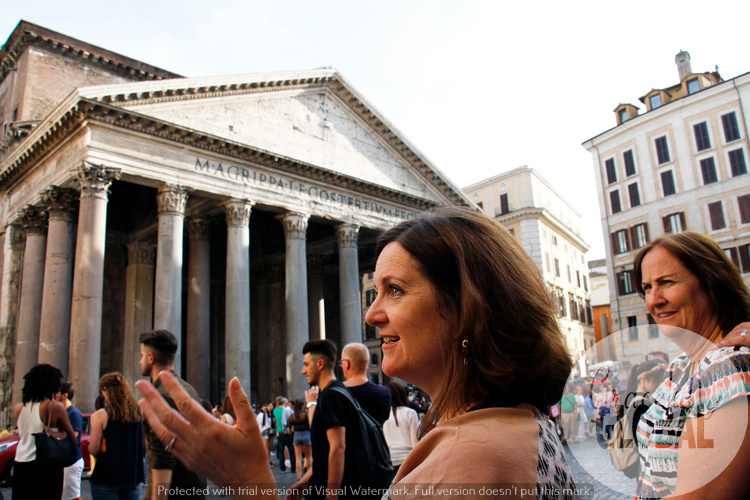
With my family sufficiently briefed on the Pantheon, we headed to the next bar, and within a five-minute walk, we found ourselves in a sea of fun and chic bars and restaurants that were anything but tourist traps. I’ve been in the area of the Pantheon umpteen times, and I never knew it took so little effort to get away from the touristy cafes. Our destination was Bar del Fico, where Fiona helped me improve my Italian by explaining the origin of their name. I’d always known that “fico” in Italian was a similar slang word to our version of “cool,” but I had never known that outside the slang, the real definition of the word “fico” was “fig.”
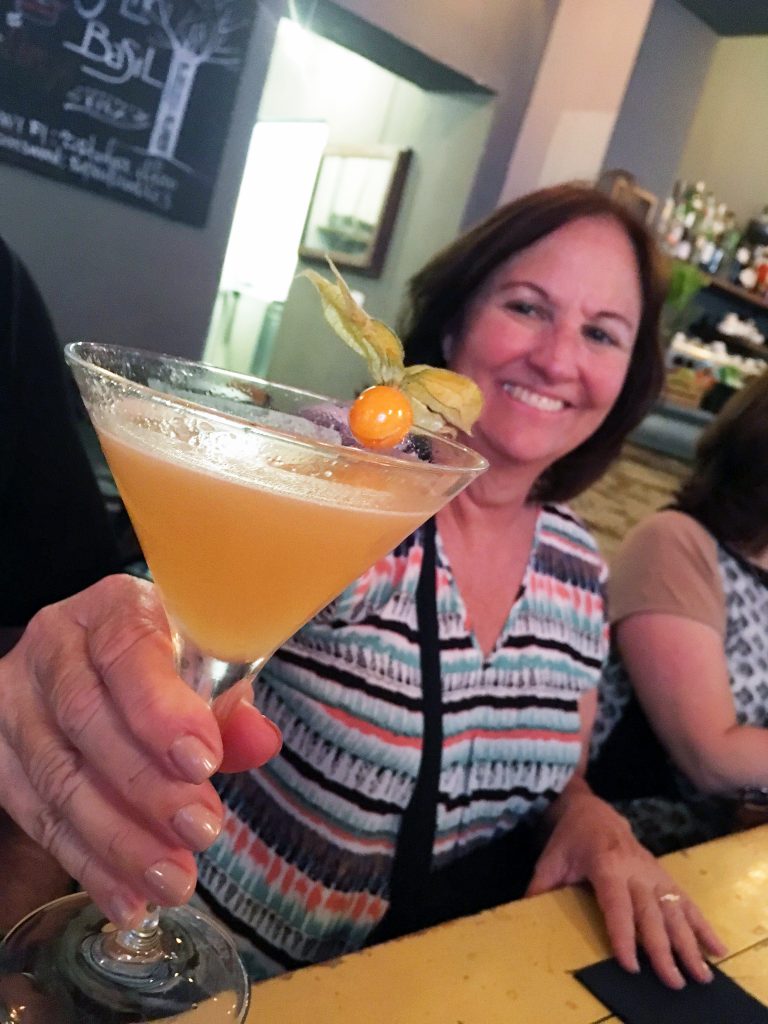
The bar was named after a beautiful fig tree standing proudly out front, under which crowds of men were hunched over chess boards, playing to their heart’s content amidst the bustling little square full of action and life. I loved this place, such a great find, feeling so far away from the typical tourist destination, yet actually, just a five-minute walk away.

Next, Fiona diverted our tour to the French church, San Luigi dei Francesi, to see a Caravaggio painting. This diversion was a personal passion she wanted to share with us, as she loves art and is fascinated with the life that the painter Caravaggio, a feisty character, led in Rome.

As we sauntered to the next bar, she shared stories about Caravaggio’s antics in Rome in the 1600s and pointed out places where he had lived and frequented. She also stopped to show us how to properly get water from the famous Roman drinking fountains.
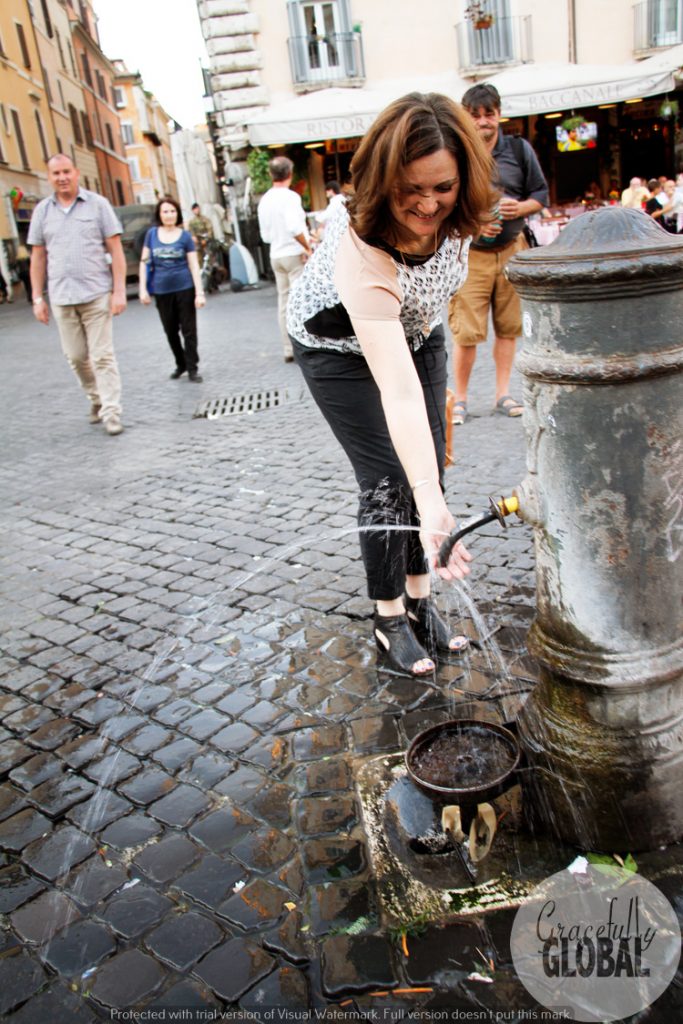
Now was the moment I had anticipated: crossing the Ponte Sisto bridge into Trastevere, and enjoying this lovely, spirited neighborhood on a Friday night. My family would have never gone to this area of Rome if it weren’t for the tour, and were grateful to take in the sunset over the River Tiber from the bridge, and the fabulous vibe of couples and families hanging out, playing music, and taking in the beautiful scene.
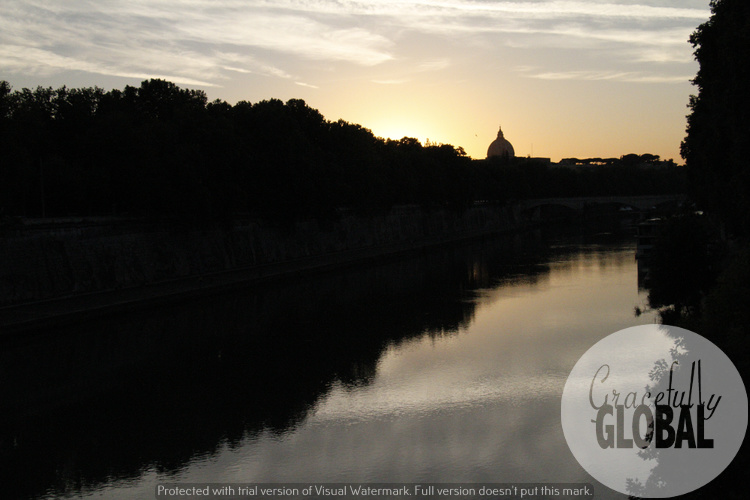
The next bar was just a short walk from the bridge at the edge of Trastevere, famous for having one of the best cocktail-makers in the city, and a fabulous aperitivo. My family hadn’t yet learned about the fantastic world of aperitivo, where a drink purchase buys you access to a free, endless buffet.
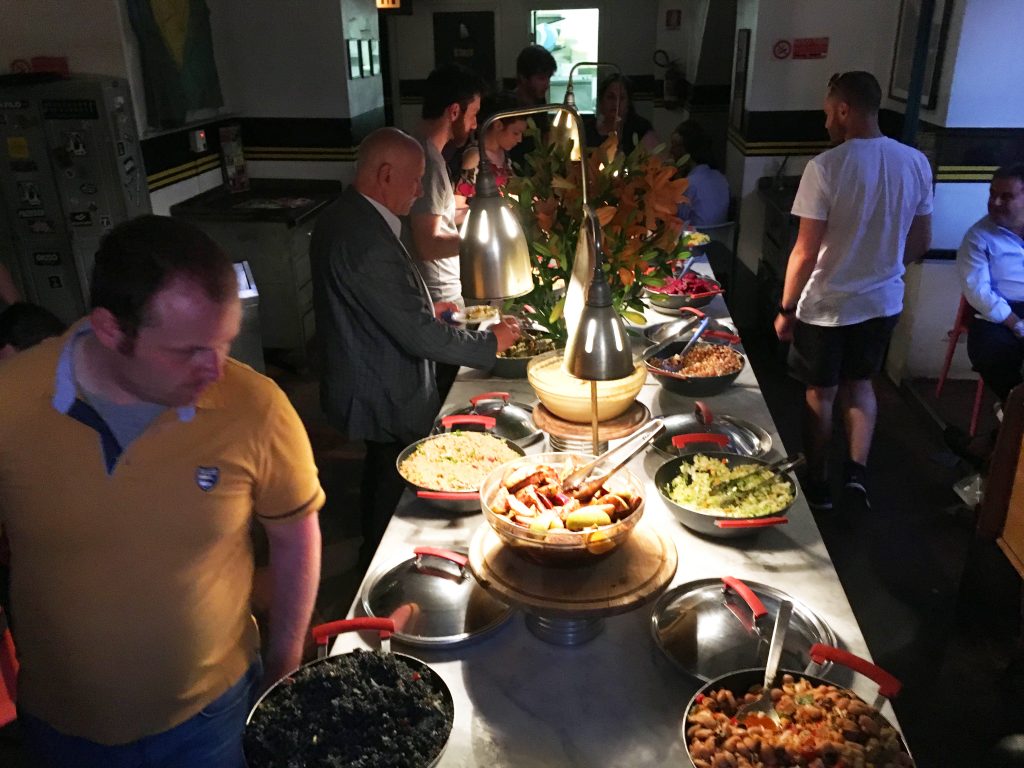
I, on the other hand, lived on aperitivo when I was a poor student in Bologna. We fondly call the act of eating aperitivo for dinner “apericena,” meaning, “aperitivo” plus “cena” (dinner). We apericena-ed happily this evening, enjoying the rambunctious crowd on the patio.
By the end of our cocktails, my family was admittedly exhausted. It had already been a full evening, and were feeling the jet lag. Nonetheless, we couldn’t finish the tour without stepping into the famously windy streets of Trastevere, and also not without a bit of dessert. Fiona had just the place, and we soon found ourselves standing outside of a little bar, Vendita Libri, Cioccolate e Vino, that only offered chocolate shots with raunchy names. We were thrilled.
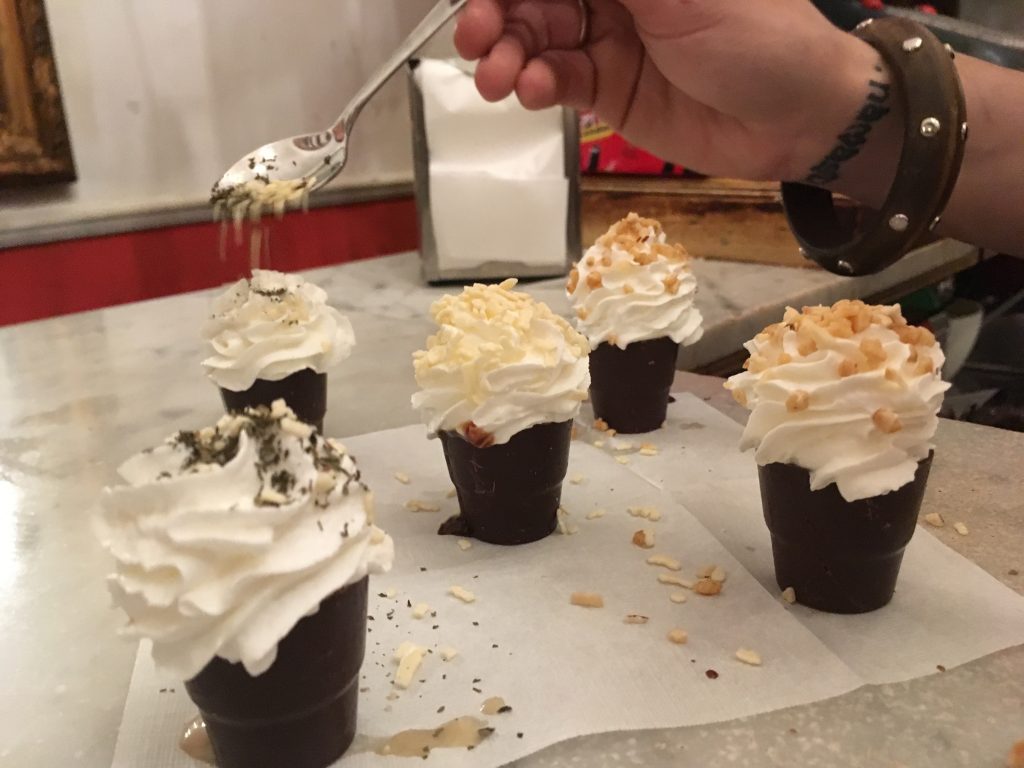
We all selected our shot, blushed a little when we ordered it, and watched the bartender combine all of the delicious components into little chocolate cups topped with whipped cream.
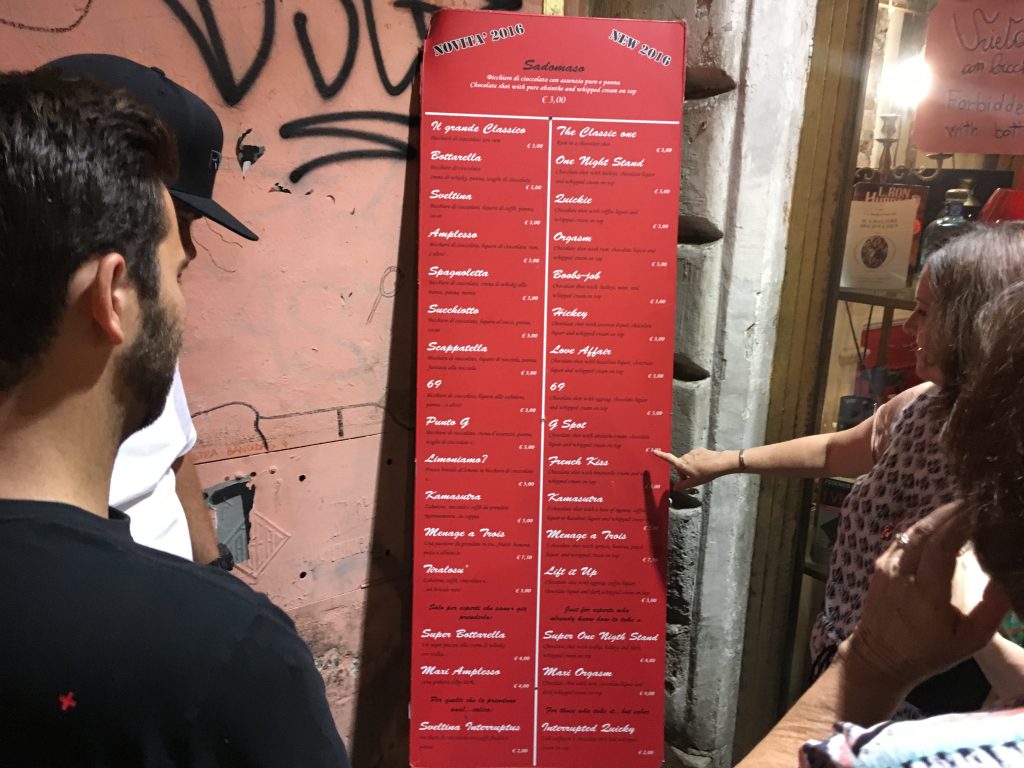
The catch was, we were firmly instructed by the bartender that we must insert the entire shot into our mouth, which we all laughed our way through, some of us with more successful outcomes than others.
We ended our evening with a walk to the taxi stand a few blocks away. My sleepy family got in a taxi and were off. Fiona and I exchanged a hug and a goodbye, and I walked back to my Airbnb in Trastevere. To me, that’s the mark of a good tour guide…someone you’d like to stay in touch with. I hope to see Fiona again on another tour or just around town. And despite the jet-lag, my family considers this evening on The Roman Guy’s cocktail tour the highlight of their trip to Rome.
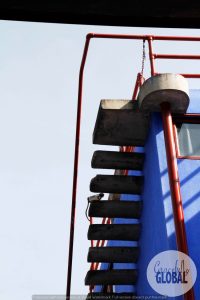
It is hard to imagine that two artists alone could make an indelible mark on a city that would sustain for decades, a century, or more. Yet Diego Rivera and Frida Kahlo’s legacy in Mexico City – the fifth largest city in the world – is still very real and tangible. As a photographer, theatre artist, and arts advocate, I feel at home in cities that embrace art, and Mexico City is no exception. I relished every opportunity on my recent trip to experience the Mexico that Rivera and Kahlo knew and loved, taking in their art and visiting their homes and haunts.
In fact, I dedicated an entire day-and-a-half of my Mexico City vacation to my immersion into the world of Diego and Frida. Here’s where I went:
Museo Estudio Diego Rivera y Frida Kahlo
Calle Diego Rivera 2, Álvaro Obregón, San Angel Inn, 01060
+52 55 8647 5470
The home and studio of Diego Rivera where Frida Kahlo also lived and worked for many years, famous for its incredible architecture by Juan O’Gorman.
Time needed: 1 to 2 hours
I woke up in Veracruz City on the second to last day of 2016 having no idea I’d be going to bed that night in a jungle. Our hostel owner at the Oyster Hostel in Veracruz moonlights as a tour guide and is passionate about the many offerings of the dynamic state of Veracruz, especially the region of Los Tuxtlas around Laguna Catemaco which was our destination that day, compliments of his comfy mini-SUV.
We spent much of the day in the car, winding through the rural countryside of Veracruz on our journey to Catemaco, making pit stops along the way at a famous Cuban-style cigar factory, and a humongous waterfall. The people-watching was as good as it gets.

There was “animal watching” too, unfortunately. I witnessed a group of turkeys standing in the rain along the road, very malnourished and somehow given up on life as their owner tried to hawk them to passing cars. That was depressing.
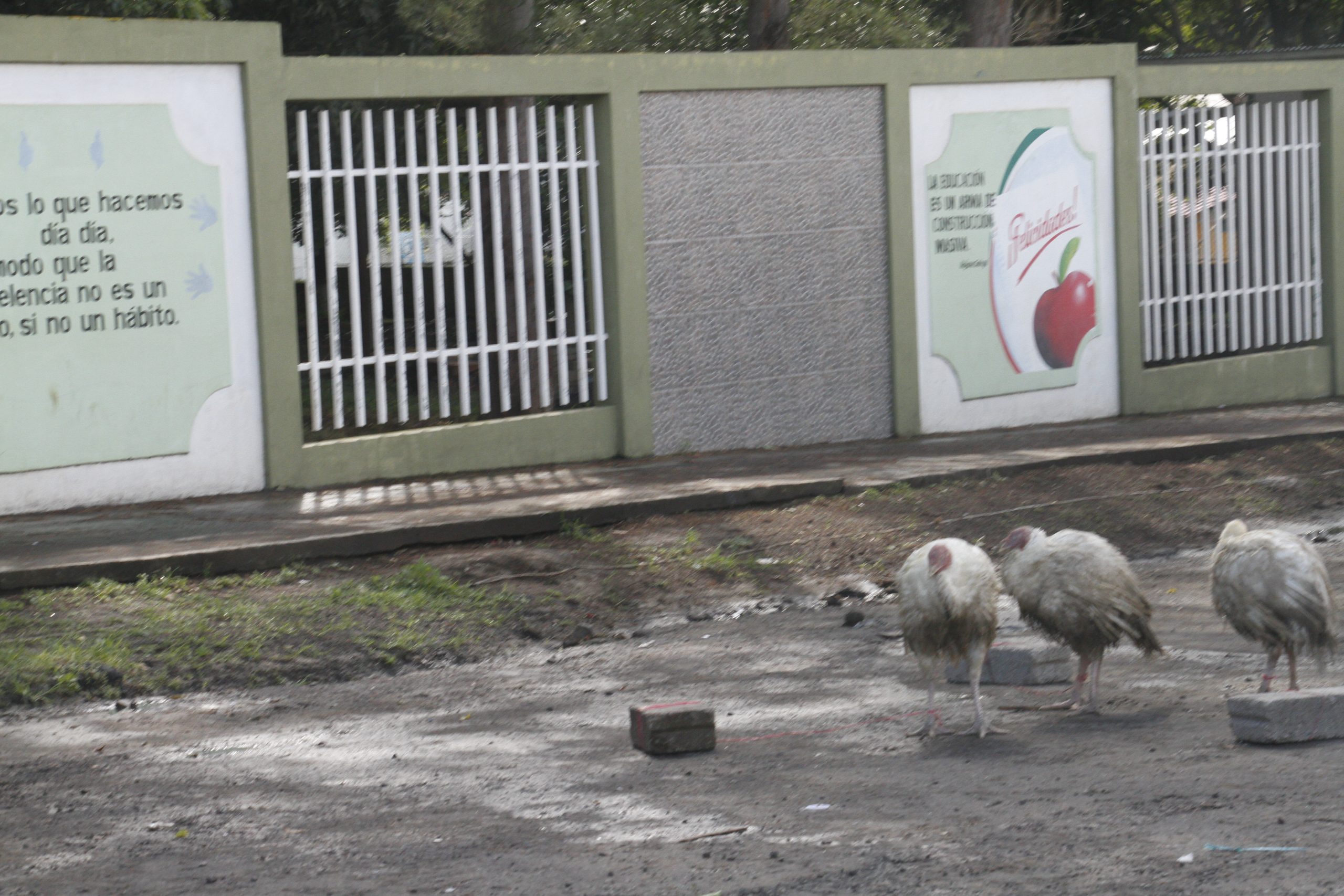
But Catemaco wasn’t. We had no idea what to expect, which is somehow the best of ways to approach a new place. After arriving, we spent the rest of the late afternoon exploring Laguna Catemaco on a boat owned by a friend of our hostel owner.
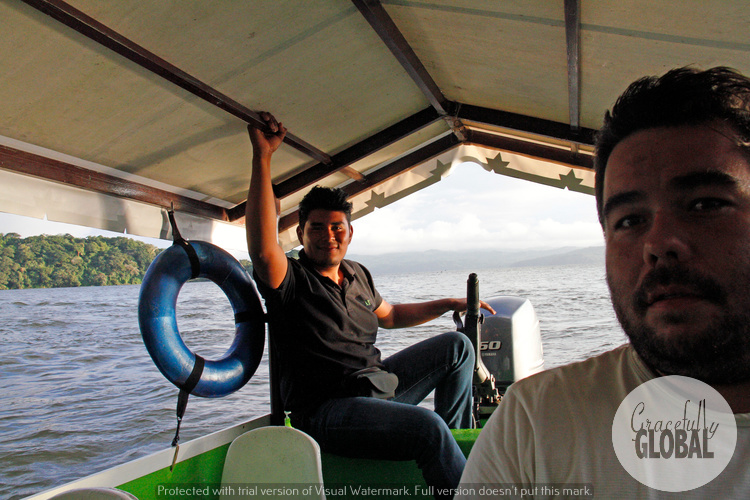
From land, the scale of the lake was impossible to recognize, as the lakeshore was lined by trees. But when we actually got on the lake, I was overtaken by the size. We sped along on the boat so quickly that the bumps of waves we hit started to feel like concrete speed bumps that sent us flying, over and over again.
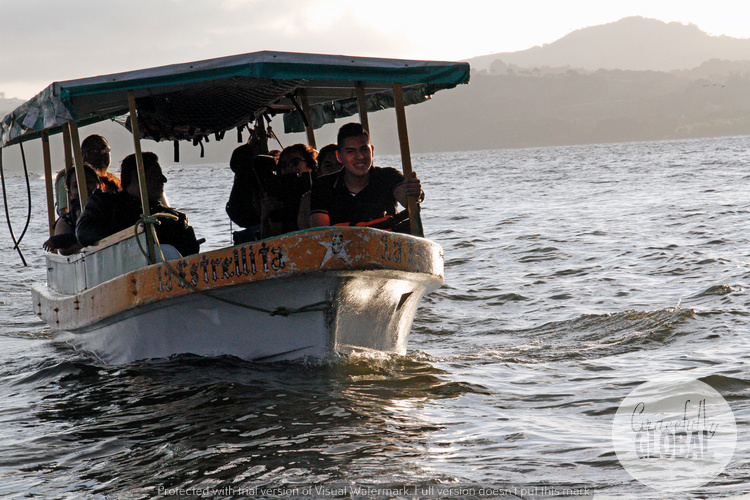
We explored every corner of the lake, from a lakeshore stop for volcanic mud face masks offered by the wife of our boat guide outside the vacation home of the owner of the cigar factory,
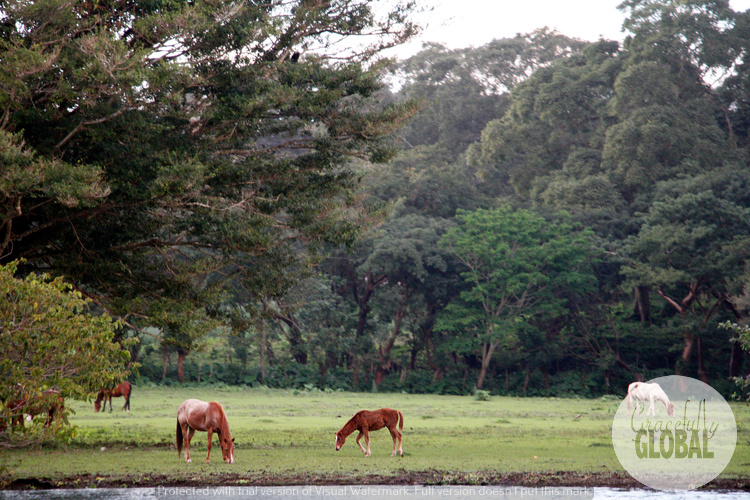
to the sunset stop to drink water from a hole along the lake where naturally carbonated water comes up from the earth,

and finally a pause in our boat to roll along the small waves of the lake for a few minutes and watch the monkeys on a small island.
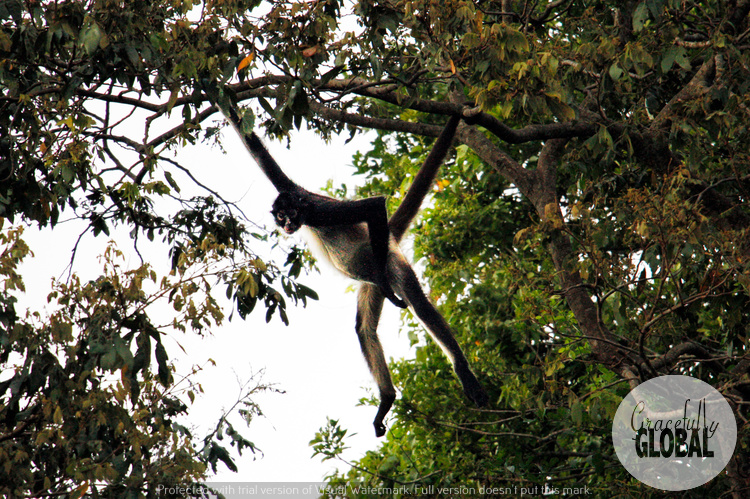
My favorite moment was turning the boat to the west and darting off into the sunset, as the least bashful of the monkeys watched us disappear while peeling a banana another boat had thrown at him.
We went to bed that night in one of the two guest rooms off of a coffee shop.

I showered with no hot water and went to sleep hoping the thousands of birds that populated the trees along the shore wouldn’t wake us up too early. Luckily, I woke up surprisingly refreshed the next morning, the last day of 2016, and enjoyed talking to the other guests over breakfast. They asked what our plan was for the day, and I told him we were exploring the Reserva Ecológica de Nanciyaga, which is supposedly the most visited fee-based attraction in the region of Los Tuxtlas. In other words, there weren’t many other options.
The reserve’s name, Nanciyaga, comes from the Nahuatl language and means “at the end of the Nance trees.” I did some research on the area, and the discontinuous rainforest belt of Middle America reaches its northernmost extent on the mainland in southeastern Mexico. Apparently, the forest in this region is not a rainforest, though, and is instead considered to be a moist forest.
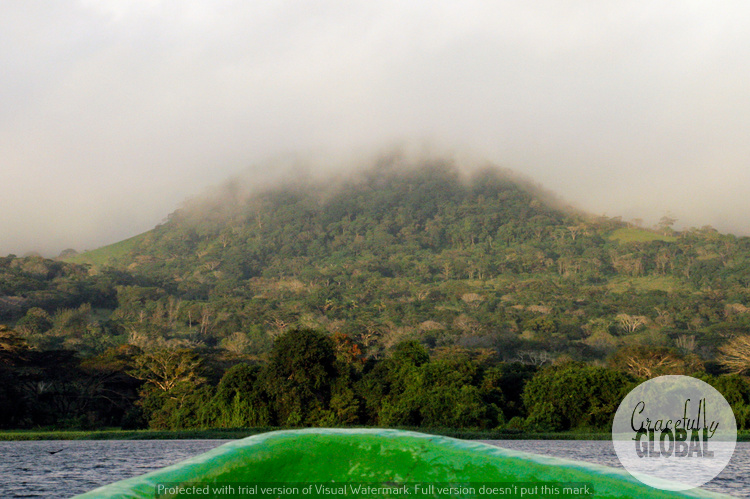
Ha! Whatever that means.
We easily found a taxi to drive us the beautiful four-mile stretch along the lake to the reserve, the same route we had taken by boat yesterday.
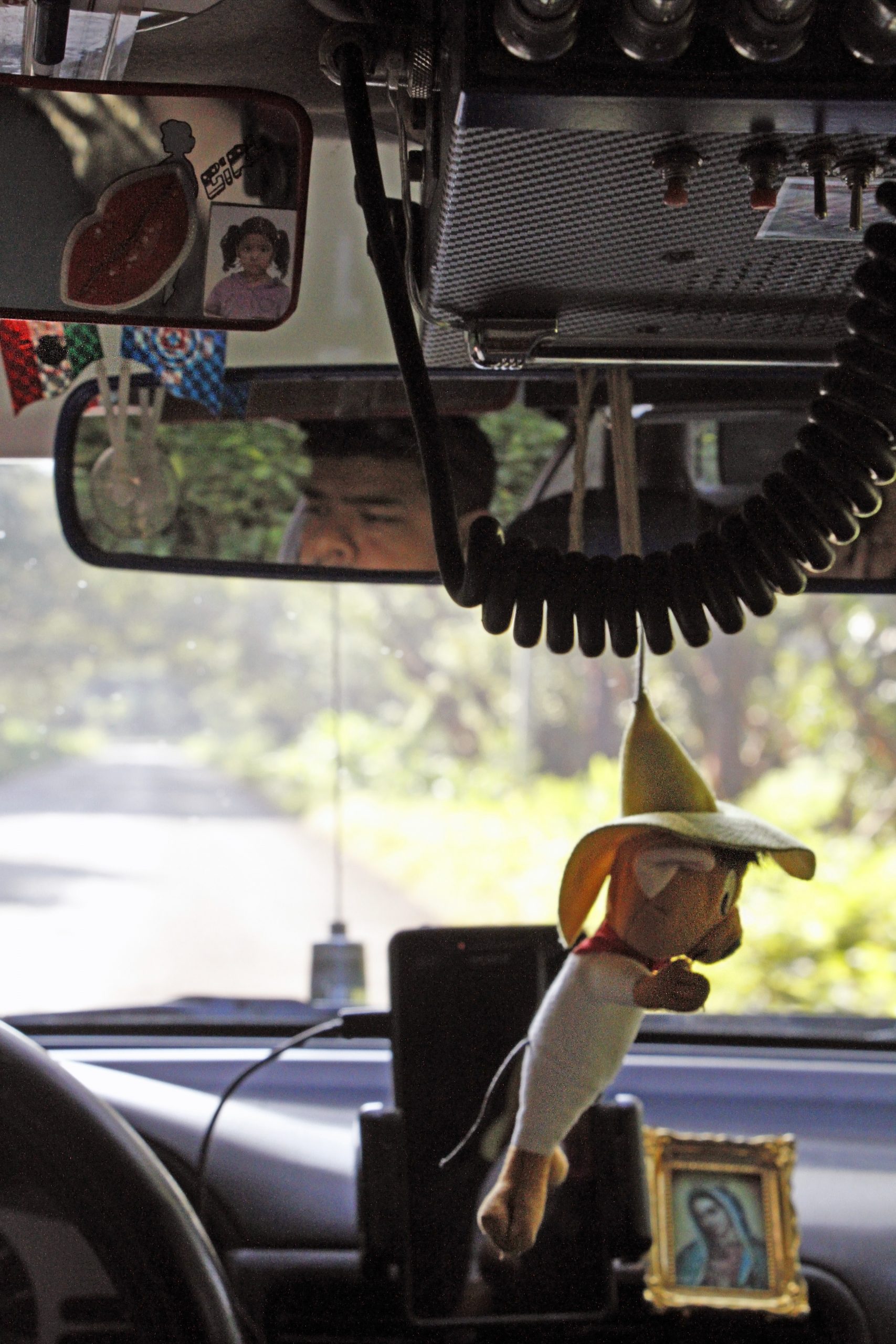
I was apprehensive about what we would find at the nature reserve, bracing myself for potential encounters with caged, unhappy animals, which happens sometimes when groups market themselves as sanctuaries to increase tourism.
When we arrived we were the only ones in sight other than the nice woman at the wooden ticket booth. I don’t remember how much we paid to get in, but it was around five dollars each, and maybe even less. After paying, the woman waved us toward a young man carrying a tall stick, who turned out to be our volunteer guide. Instead of letting us wander around on our own and get ourselves into trouble, this young gentleman took us up and down the winding dirt paths and through a history of the ancient Olmec culture, and a bit of a background on the wildlife that call the Los Tuxtlas Biosphere Reserve home.
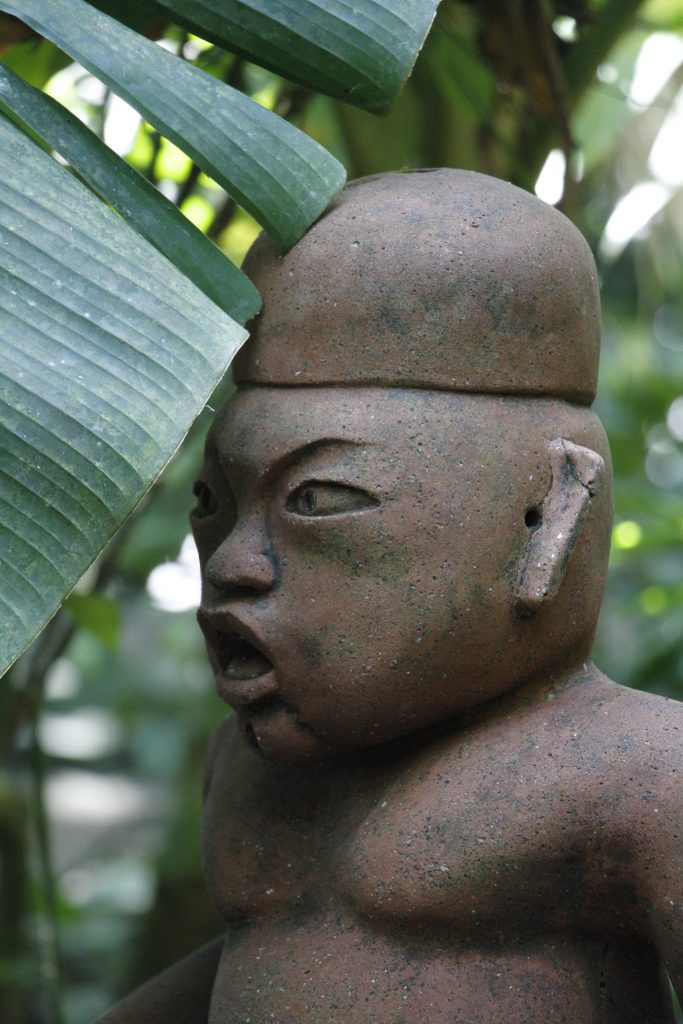
The ecological park is a self-sustaining property made up of ten acres along lake Catemaco including a mineral spring (Nipapaqui natural hot tub), a tiny lagoon for swimming, small bungalows that accommodate overnight guests, and a wonderful open-air restaurant serving three meals a day to guests, but closing at sunset for those not staying on the property.
Really, though, there was so much more to the property than expected, which we discovered through our sweet young guide. We stopped along the dirt path as we encountered random replicas of Olmec sculptures he used as talking points. Highlights of the property included the temazcal (sweat lodge), which is actually functioning, and group treatments are scheduled throughout the month.
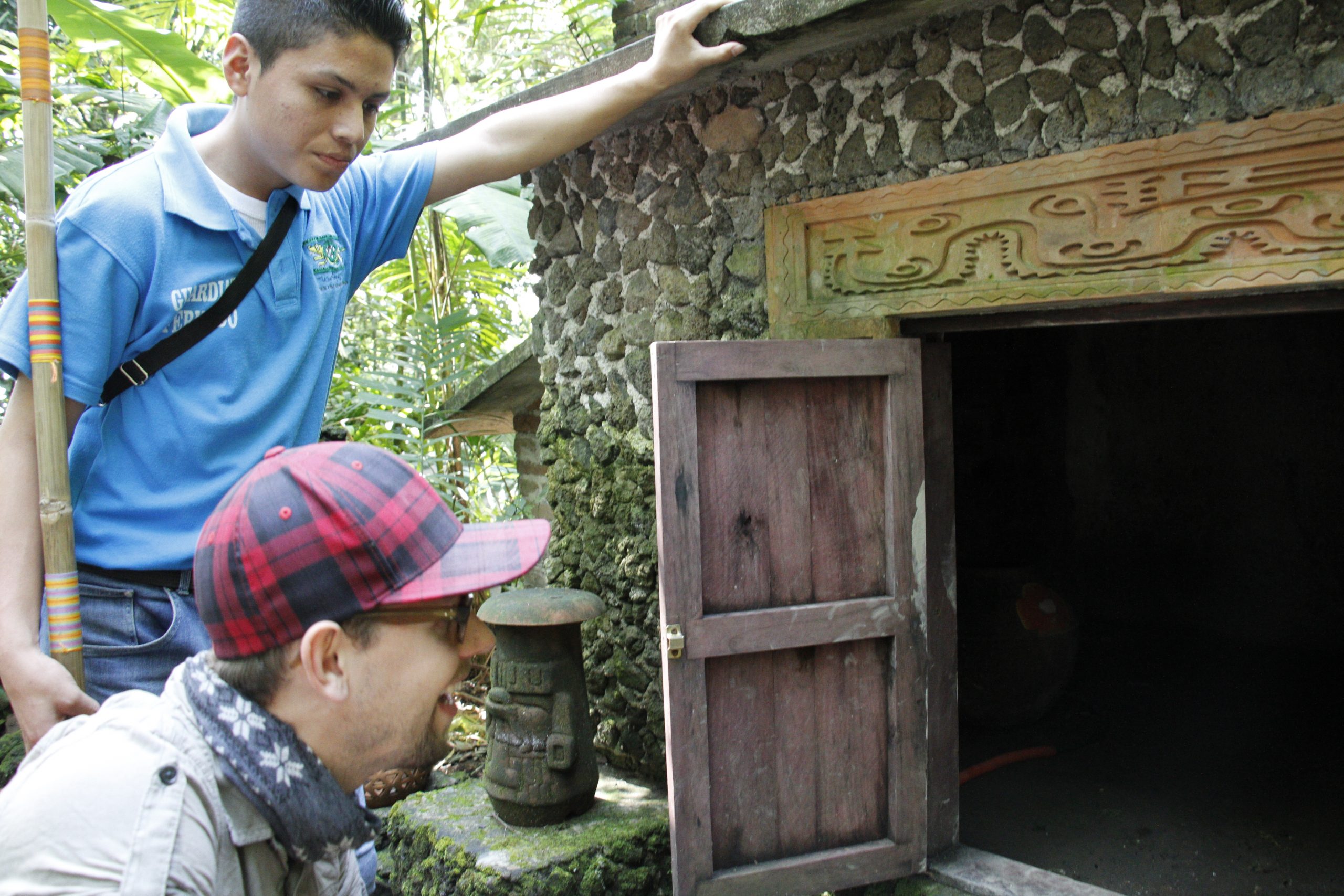
As a theatre person, I loved their outdoor amphitheater. And then, of course, I was shocked-but-not-shocked at the wall of printed photos of guests in mud baths, mixed with pictures of celebrities. Apparently, parts of Medicine Man (1992) with Sean Connery and Lorraine Bracco, and Apocalypto (2006) with Mel Gibson were filmed here. The owner, a woman, is happily pictured in a photo with Mel Gibson.

After enjoying the photo wall, we entered the wooden structure and found ourselves in a small but clean and lovely open-air salon.

My friend enjoyed a mud face treatment, while I purchased the dried mud and some patchouli soap to take home. Folklore claims a princess used to cross over from a neighboring island to use the mud in this region to beautify herself. I took that as a strong hint I should be doing the same.
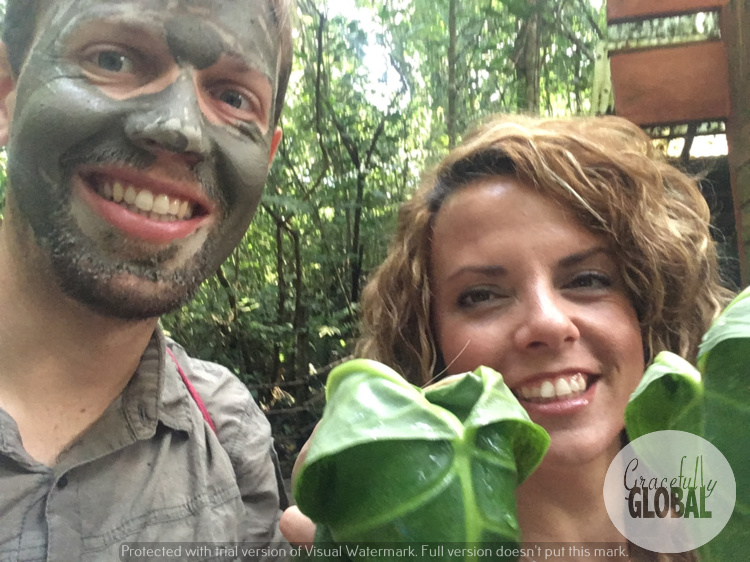
Once my friend’s face was thoroughly green from this miracle mud, we left the salon to discover rows upon rows of tied leaves laid out for us to select from. I was bewildered, as everything was in Spanish, so it was becoming a bit hard to keep up with all the surprises. I followed my friend’s lead, green face and all, as he picked up a leaf and dipped it into a bucket of water. To my surprise, the leaves were watertight, and the water was carbonated. I took a gulp from my leaf cup: the water had a familiar taste, and I wondered if they pulled it from the same hole we had drunk from the evening before. This was the first time, and possibly the last, I had drunk from a leaf. So far, so good. I was thoroughly charmed by our jungle adventure.
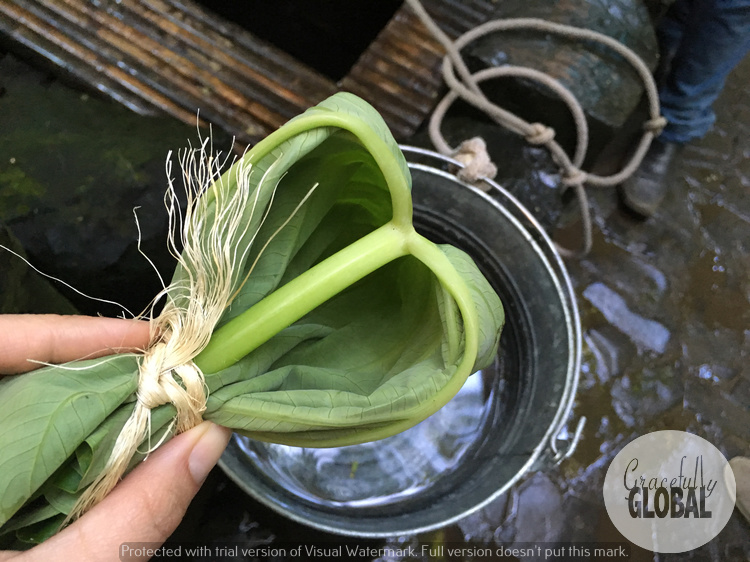
But the surprises didn’t end there. The handy leaf cup maker, a nice young woman, asked if we wanted to have a “White Magic” treatment. I wasn’t aware of this at the time but later discovered from the mother of great friends of mine near Mexicali, Mexico, that this region of Veracruz was famous, or perhaps infamous, for its traditions of magic. My friend and I decided to participate together, and we spent a thoroughly unusual but surprisingly pleasant five minutes being swept with leaves as our white magic doctor chanted and prayed around us. At the end of the ceremony, he presented us with a clay ceramic face on a ribbon to wear around our necks, that he had blessed for us to ward off the spirits. I keep it in my purse. I figure I need all the help I can get. ;b
Our adventure continued alongside an algae-filled lagoon inhabited by more than a few crocodiles and turtles, with a fence separating us humans from these prehistoric-looking characters. They were as still as statues.
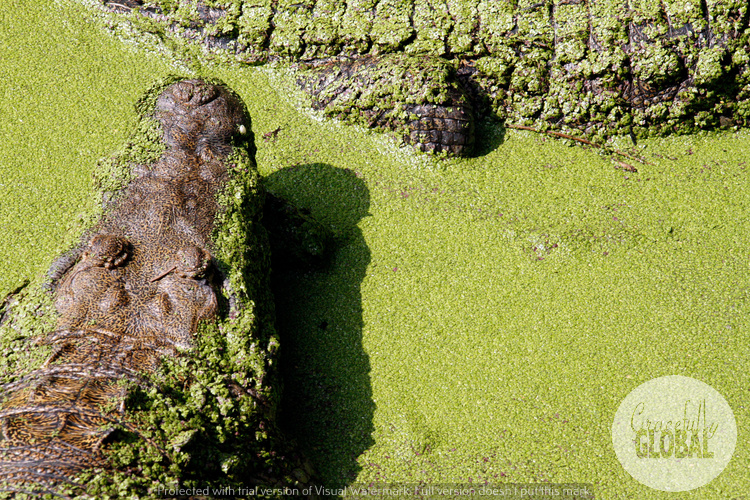
And the turtles perched along the long wooden logs looked like a cartoon.

Along with these guys, the area is apparently known for rich birdlife, including toucans and parrots, which we saw from a distance.
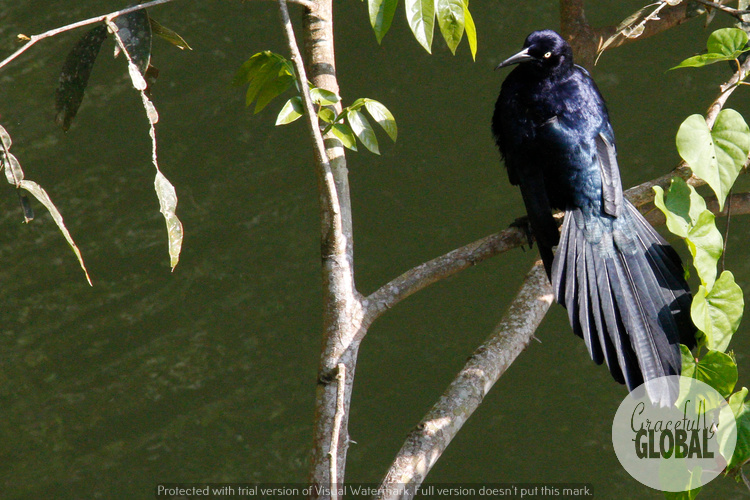
In 2003, a few Howler monkeys were reintroduced in the reserve which apparently did well. We saw a large iguana and babies. And we didn’t see any unhappy animals. I was relieved.
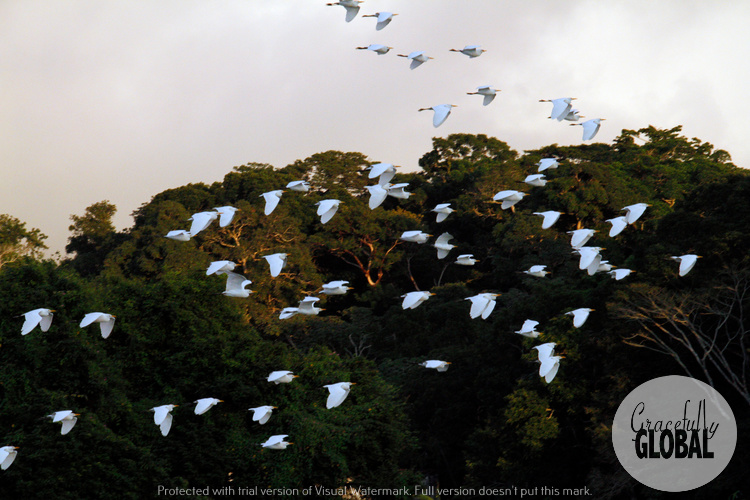
Our tour wound down, and our guide showed my friend where to wash off his mask.
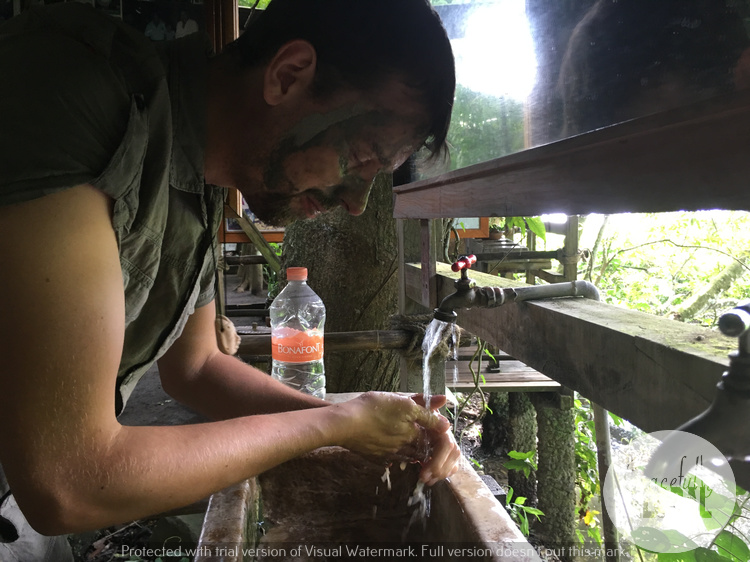
Bowls of fresh patchouli leaves adorned the sinks, and our guide smiled and encouraged me to use them as my soap.
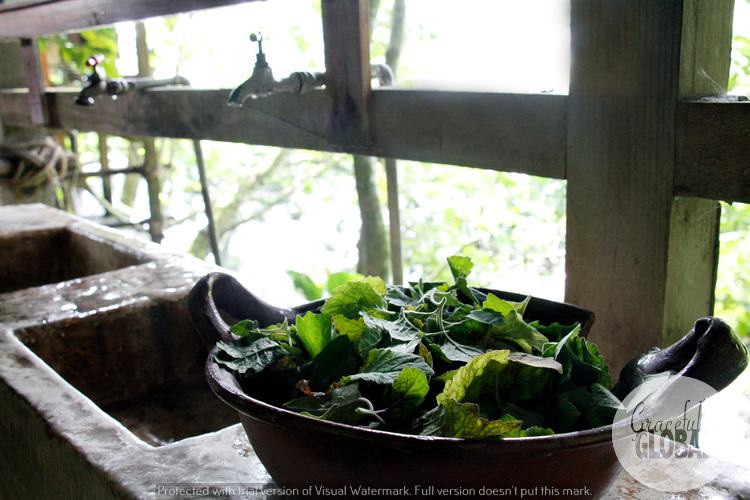
I loved them: the fiber seemed to scrub my hands clean and left a wonderful scent. We tipped our guide nicely as he handed me back my soap and mud that he’d carried, and we bid each other goodbye, at which point we were let loose in this little paradise! I was thrilled. It was lunchtime, and lunch at the open-air restaurant seemed like a perfect idea.
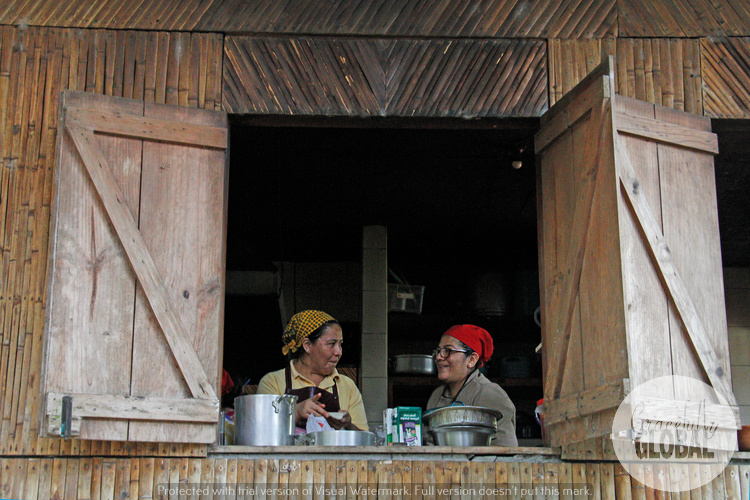
We talked to a chef who managed the dessert bar, and she showed us some of the traditional cakes that they offer, tempting us to leave some room for later.
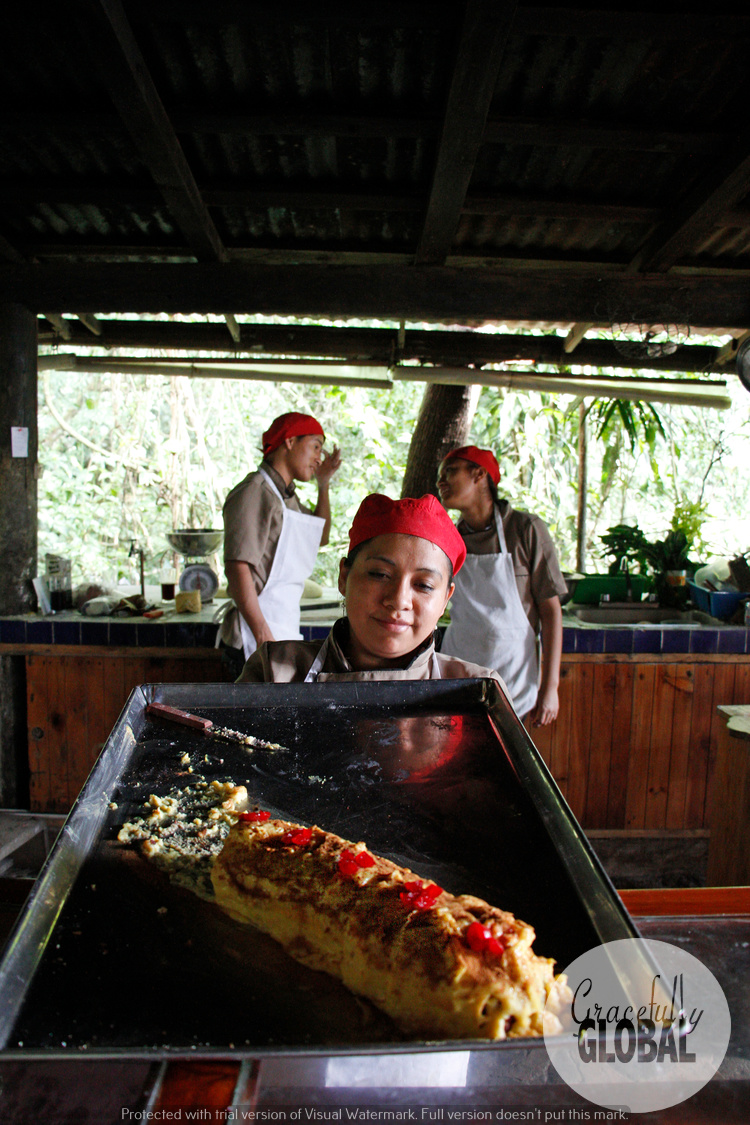
We enjoyed a thoroughly relaxing, delicious lunch on the lakeshore, a beautiful piñata blowing in the wind above us.
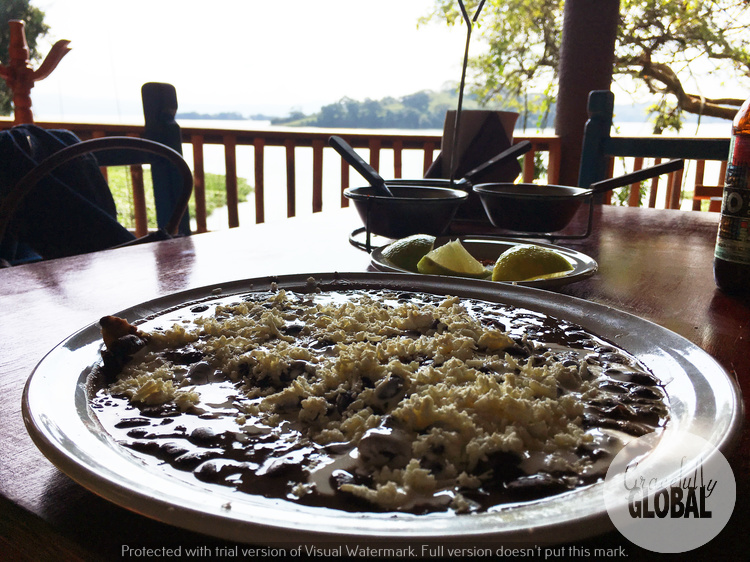
After lunch, we made our way back up the winding dirt paths to the wooden ticket booths and asked the woman to call us a taxi. While we waited, we chatted with the volunteer guides waiting for the next visitors to arrive. They were local students and all very proud to be a part of the reserve.
The visit couldn’t have gone better. I’ve promised myself I will return, and next time I will stay at the reserve. Full of good energy, happy people, and happy animals, this is the type of place I want to go to remind myself how much there is to appreciate in life, despite our everyday stresses and challenges.
And until my return, I luckily have quite a store of mud mask to tide me over. I put it on and pretend to be the princess of Catemaco. 🙂
For more information on Nanciyaga, visit this helpful website apparently maintained by an American ex-patriot not affiliated with the reserve.

As the host of the oldest university in the western world, Bologna has been a second home for young people from across Europe for centuries. And with the saturation of young people comes the inevitable nightlife of those who don’t have morning meetings and people depending on them to make breakfast.
I’m one of those students that made my pilgrimage to Bologna, only to be charmed by the nighttime energy of this city. Only in Bologna does coming home at 3am on a Saturday night feel early. After five years of this, I’ve finally learned to prioritize my favorite places, and cut my nights short so I actually come home before sunrise. Sometimes.
The energy of the city is visceral, and therefore photographable. Instead of always wasting my nights away in laughter and Italian wine, I’ve started shooting instead. Or at least, taking a few minutes to shoot on my way home, ha! My new lens is a f/1.8, and the results have been fantastic. I hope you enjoy my meanderings through the streets of Bologna, seen below. And stay tuned for a vlog coming soon, featuring interviews with Bologna’s best bartenders!
















My mom sometimes worries – as many moms do – that she hasn’t been the best mom. But “best” in this case, as in every case, is just relative. Who in this case would be the definitive judge of all moms in terms of being “the best?” Donna Reed? Michelle Obama? Angelina Jolie? The idea of a “best mom contest” is kind of hilarious, maybe because it is such a personal role.
True, my mother was not waiting for me when I got home from school with freshly baked cookies. Or tagging along on my school trips. Instead of living her life through me and my activities, my mom was pursuing her passion for art, and bringing me along on that ride of discovery. I can think if no better way of learning about life and living than through art, and for that, my mom is the best mom, for me. 🙂
When I was in her belly in Togo, West Africa, she was scouring the African beaches for the most beautiful shells, and taking them home and sketching them.
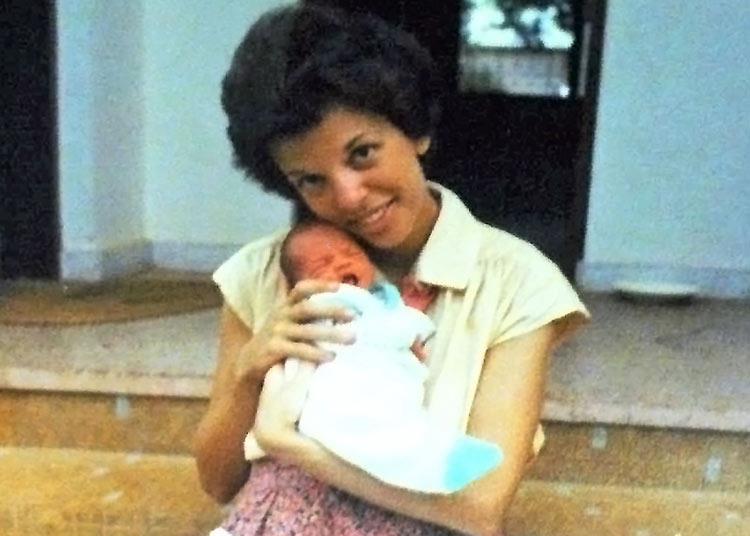
When I was a toddler, she was pursuing her masters in photography at Indiana University and using me as her model as she experimented with large format photography.
When I was in grammar school, she was forging new artistic territory in our border home in Southern California, setting up photography exhibits of her hip-shots in Mexicali and large format photography of Mexican families. She would often bring me with her to Mexico when she was shooting. Even as a six-year-old I would get nervous crossing the border, and worry that I would forget where I was born when the border patrol agent asked me. She would always patiently remind me.
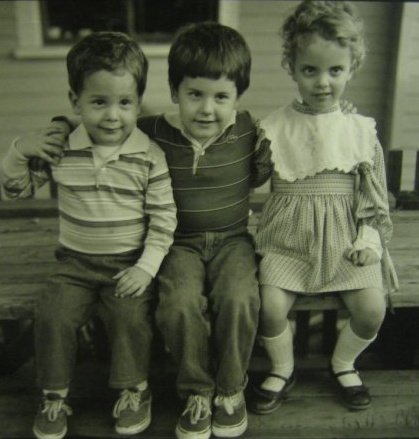
When I was in high school, she was working long hours as a newspaper photographer, documenting the stories that needed to be told in our low-income community. She would bring me along on stories she knew I would especially love, like watching baby pigs be born late one night, and visiting a buffalo farm.
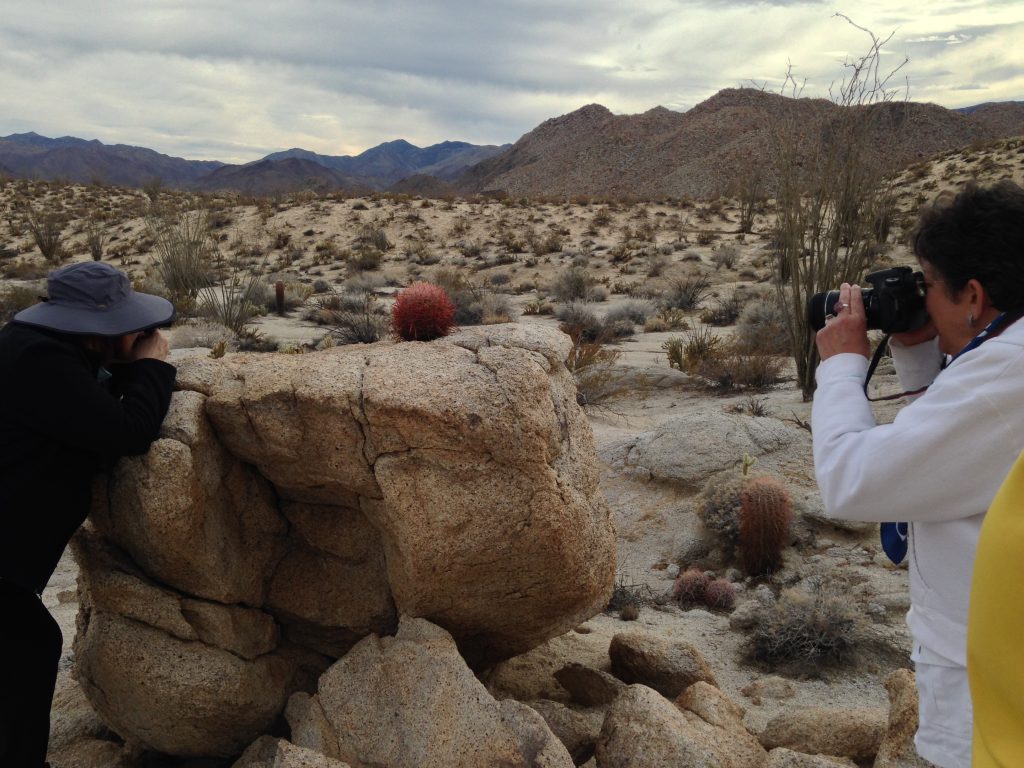
She painted in the little spare time that she had. Now, my mom’s art is sculpting the environment of her backyard, a garden oasis in the desert.
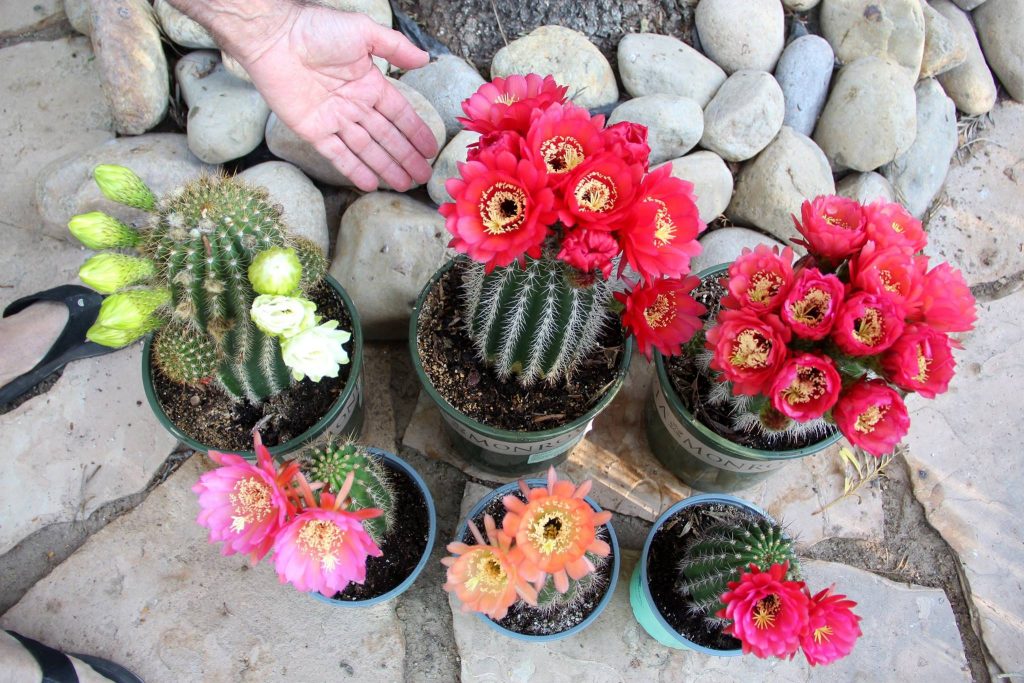
I thank my mom for giving me a love and ability for art both through nature, and nurture.

But better yet, the drive behind my mom’s pursuance of art is perhaps the best qualities she has – curiosity, passion, intelligence, and independence. Having had a mom that waited for me to get home every day would have given me a lot of security, but instead I was given something that I think I needed more. Independence and curiosity are instrumental qualities for being a successful traveler and photographer, and I don’t think I would have ever been able to realize my life of traveling without these skills my mom taught me as a role model and as her apprentice.
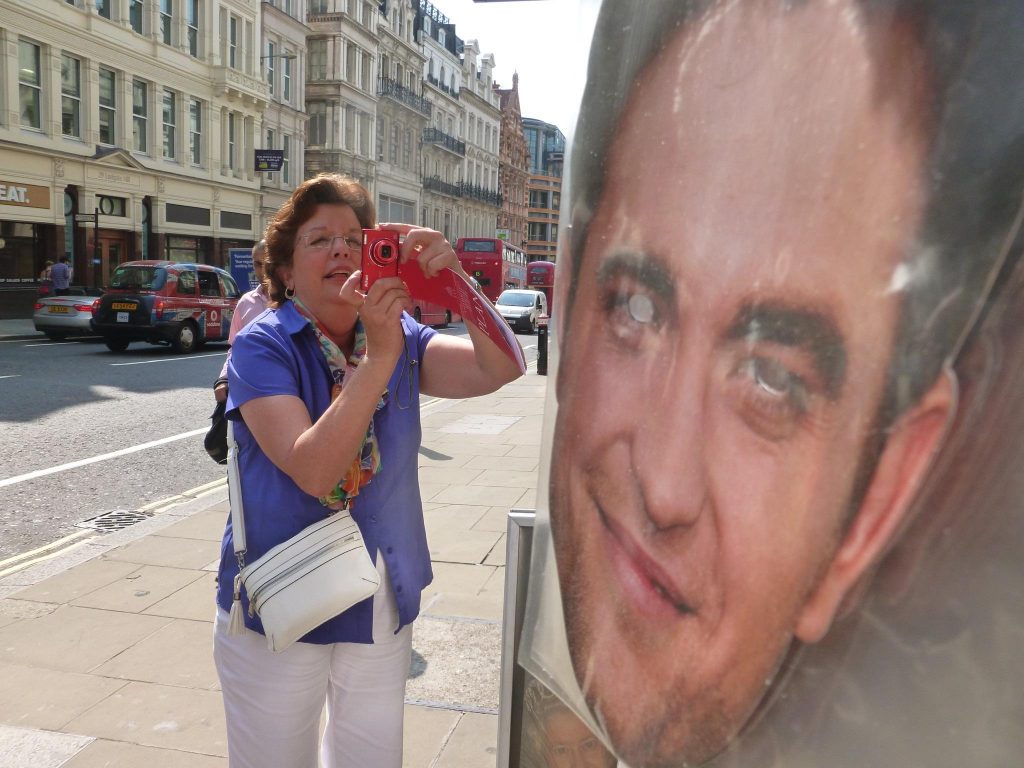
So on this day I hope my mom, and all moms, know how much they have given us, and can challenge themselves to enjoy that, without worry or doubt, for at least the twenty-four hours of this awesome day, Mother’s Day. Happy Mother’s Day Mom!!
